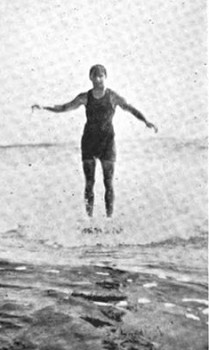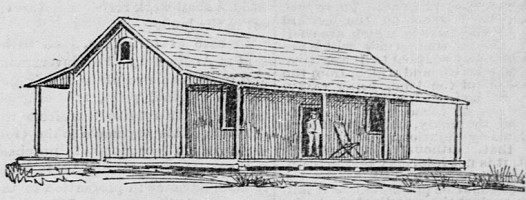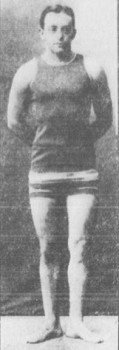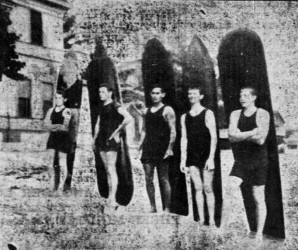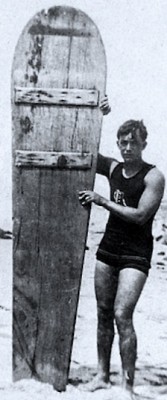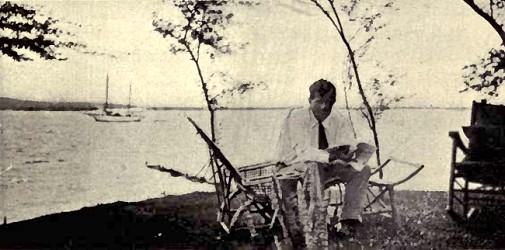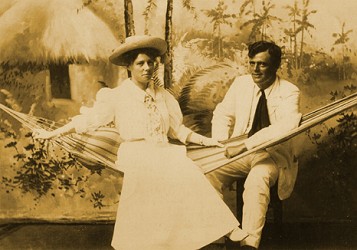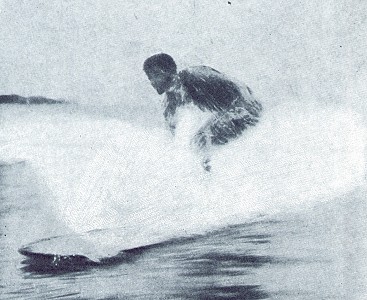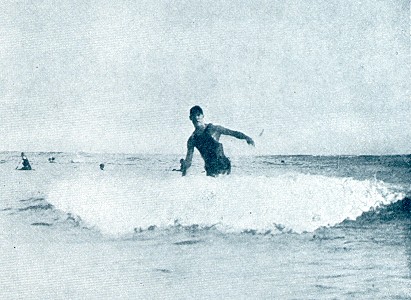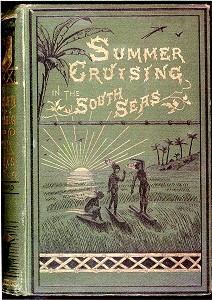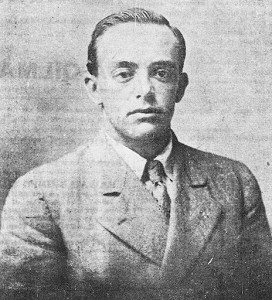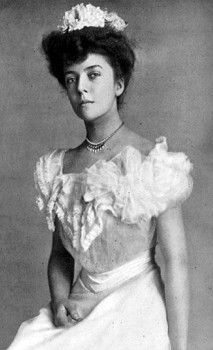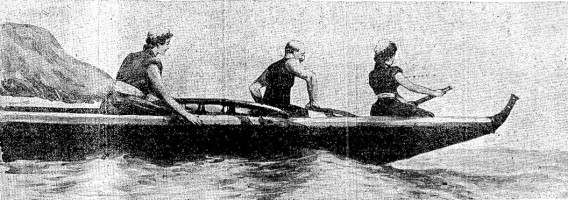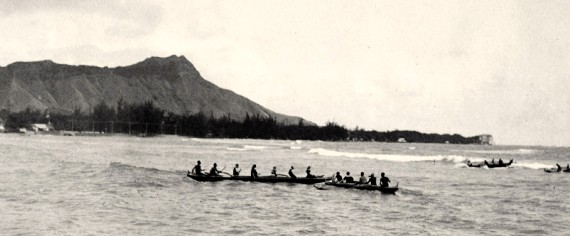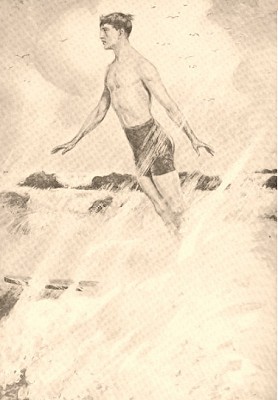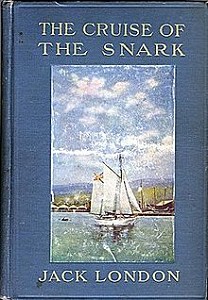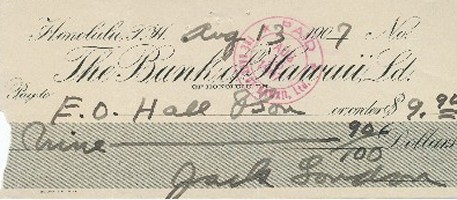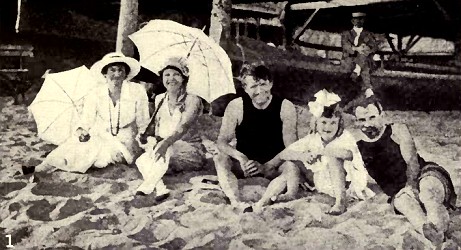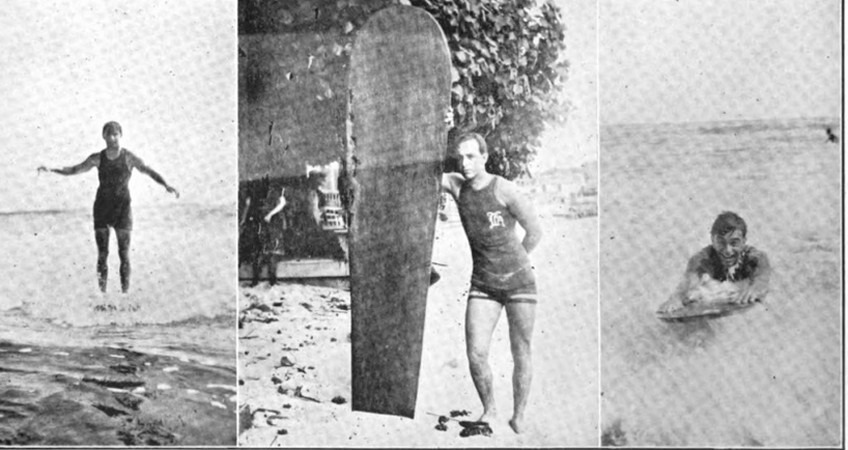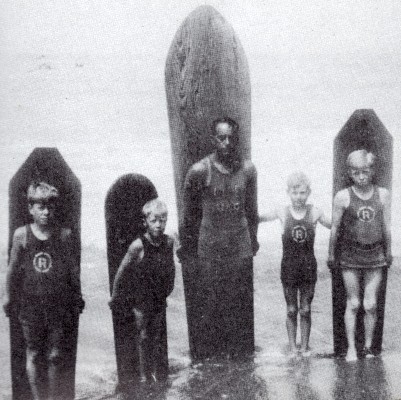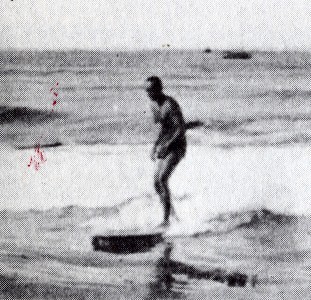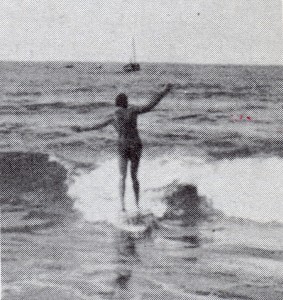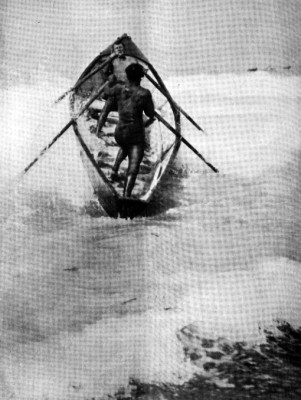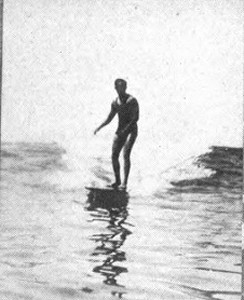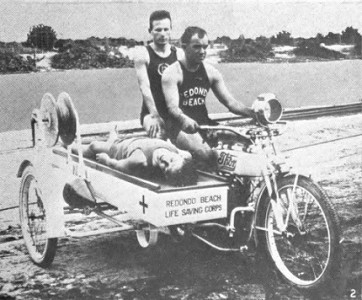Surfing on wooden surfboards really got underway in Peru around the time of World War II.
What follows is a complete history of that period, the years afterwards and the trace back to Peru's earliest surfing history.
This chapter is also available as an eBook for $2.95 by clicking on the Paypal link below. The advantage of the eBook is that it is completely portable and can be shared and passed on to others. Importantly, the hyperlinks embedded in the book make navigation very easy and vintage Peruvian photos are included:
The Early History of Peruvian Surfing
By
Malcolm Gault-Williams
Contents
Introduction
Peru is rich in surf history. While we can only conjecture as to its earliest days of riding reed craft, the stories of the early days of Peru’s modern era are now legendary across the planet.
I am indebted to the following for their contributions to this 23,069-word look at the early days of modern Peruvian surf history:
First and foremost is Oscar Tramontana Figallo, whose work in documenting Peruvian surf history was invaluable. Coming a close second is Felipe Pomar, who took time out to answer specific questions I had about his early days and the nature of Peruvian surfing especially in the 1960s. Thirdly, I am in much appreciation of the archival photos from Carlos Rey y Lama (viewable in the eBook version).
Although I credit everyone in my footnotes, I also want to thank – in the order of the appearance of their contributions – the following: Matt Warshaw, Ben Finney and James Houston, Peru Surf Guides, Glenn Hening, Marcus Sanders, Olas Peru, Fred Hemmings, Mike Doyle, Augusto Villaran, Oscar M. Brain and Juan Forero.
I hope you enjoy this chapter as much as I did writing it!
Aloha,
Santa Barbara, California, USA, April 2010
Pre-Inca Wave Riding
Off the west coast of South America, Pacific ground swells hit the beaches from Panama to Patagonia, producing some of the planet’s best surf. Peru, South America’s third-largest country, has a rich surfing history to go with its 1,500 miles of mostly dry and rugged Pacific-facing coastline.
“The surf in Peru is remarkably consistent,” wrote Matt Warshaw in the
Encyclopedia of Surfing,“with wave height averaging between three to six foot throughout the year, thanks to long-distance north swells during the summer, a steady feed of powerful south swells in winter, and a balance of the two during spring and fall. About 80 percent of Peru’s surf spots are lefts, most of them breaking along rocky points spilling onto sandy beaches. Daytime coastal air temperatures generally range between the low 70s in summer and the low 60s in winter; water temperatures around the capital city of Lima, chilled by the Humboldt current, range from the upper 60s to the mid-50s.”
1Surfing in Peru is centered in Lima – home to one-fifth of the country’s total population. “Peru’s wave-rich northern tip faces northwest (the rest of the coast faces southwest), warmed by the Panama Current, is home to an assortment of points and reefs, including the high-acceleration tubes at Cabo Blanco, Chicama – the arid left-breaking point known as the longest ocean wave in the world, with rides sometimes lasting more than a mile – is located about 200 miles south of Punta Negra, and is flanked by at least four other high-quality breaks. Lima’s Pico Alto is the country’s premier big-wave spot, with well-shaped rights and lefts (rights preferred) breaking up to 25 feet. The country’s southern coast is lightly populated, hard to access, and rarely surfed. The number and quality of surf breaks, however, is thought to be nearly equal to that found in the north.”
2
In addition to this surf wealth, the ancient land now known as Peru has the oldest documented tradition of wave riding.
Caballitos de Tortora
In relatively recent years, Peruvian world champion surfer Felipe Pomar has lead the charge for greater recognition of Peru’s wave riding heritage. Taking it a step further, Felipe has joined with a few surfing and non-surfing historians to argue that surfing as a sport originated in what is now called Peru. They point to the fact that pre-Inca fishermen were riding surf as far back as 3,000 B.C., riding waves on what Spanish conquistadors called caballitos (little horses) made of bundled reeds. This would put the Peruvians about a thousand years before the earliest estimates for surf riding in Hawai‘i.
The conventional history of surfing, of course, has it originating as a very basic type of wave riding originating in the western Pacific Ocean. Under this scenario,
the first surfers were Polynesian or Polynesian ancestors. If one is to discount that surfing probably began before the Polynesians reached the Hawaiian Islands, then surfing began sometime between 2000 B.C. and 400 A.D.
3University of Hawai‘i anthropology professor and early surf historian Ben Finney acknowledged that surfing was not limited to Polynesia. In his
Surfboarding in Oceania: Its Pre-European Distribution, Finney wrote that an “extensive examination of the available sources has shown that surfboarding was known in Polynesia, Micronesia, and Melanesia. In fact, surfboarding was practiced in Oceania from New Guinea in the West, to Easter Island in the East, and from Hawai‘i in the North to New Zealand in the South.” Finney cited sightings of various forms of primitive surfing in places as diverse as Owa Raha in the Solomon Islands (observed in 1949); to Yap in the Western Carolines (observed by a colleague); and south in the New Hebrides and Fiji. “With reservations,” Finney concluded, this “wide distribution would seem to indicate that surfboarding is a general Oceanic sport, rather than a specifically Polynesian sport.”
4Decades after writing the foregoing, however, Finney clarified that – lest one be easily tempted to look elsewhere than Polynesia for surfing’s earliest roots – “Indigenous board-surfing in the Pacific was most highly developed on islands within the Polynesian Triangle bounded by Hawai‘i, Rapa Nui (Easter Island), and Aotearoa (New Zealand). Early reports of surfing along the shores of islands from New Guinea to Polynesia indicate that this sport, at least in its rudimentary form, was part of the common heritage of the seafaring people who spread across the Pacific thousands of years ago.”
5
So, if Polynesian surfing began before people reached the Hawaiian Islands, it is certainly older than 3,000 years ago. The fact is, we just don’t know how old surfing in eastern Polynesia is, let alone how old it is in western Polynesia. Could pre-Polynesians have surfed? It’s most certainly probable, even if it was merely bodysurfing, bodyboarding or canoe surfing.
In fact, anywhere on the planet that has surf, a moderate or temperate climate, and coastal populations of humans engaged in fishing, there must have been surfers – if only riding surf in canoes as part of work or recreationally. Also, the tendency of young peope to get into the ocean and bodysurf is a universal act. Many historians wishing to blaze new ground often forget this most obvious aspect of coastal living in all ages and all temperate coasts.
We are fortunate that the coastal Peruvians, very early on, developed ceramic art to a high degree early in their history because they left an actual record of their surfing behind. In the museum of the Peruvian city of Chan Chan, there is pottery showing Huanchaco people “running waves” on reed rafts we now call caballitos de totora (little horses of the totora reed). These reed mats were and still are used primarily for fishing, but the pottery also indicates they were also used for fun; to ride the breaking waves of the northwest coast of Peru. Dating of the ceramic artifacts prove that wave riding on reed boats existed in that country as early as 3000 to 4000 B.C., long before the Spanish invasion in the 16th Century and well before the founding of the the Incan Empire in the 13th Century.
The two ancient pre-Inca cultures, Mochica and Chimu, developed in the north of Peru more than two thousand years ago. These were the first Peruvian societies to relate actively with powerful coastal tidal zones, through fishing and transport. The people of these societies left us many examples of designs featuring waves in their religious iconography and their art expressed on textiles, frescos and ceramics.
The first Peruvians to ride waves were no doubt fishermen who had to traverse often powerful ocean waves in order to get food. Peruvians are still using the reed craft their ancestors used thousands of years ago, now in modern times. It is possible to watch them in Trujillo; Huanchaco Beach is famous for this reason.
6“In 1987,” Matt Warshaw wrote, “[Felipe] Pomar began a one-man crusade to have the fishermen of ancient Chan Chan, a pre-Inca empire located in what is now Peru’s northern territory, recognized as the original surfers. Chan Chan fishermen from as far back as 3,000 B.C., Pomar said, used reed-built
caballitos (‘little horses’) to ride waves; a 15
th-century warrior, furthermore, on a seagoing mission to expand Inca territory, may have introduced the
caballito– and surfing – to Polynesia. ‘While there is much room for speculation,’ Pomar said in a surf magazine article, ‘there seems to be a distinct possibility that the embryonic form of modern-day surfing was born off the coast of northern Peru.’”
7“In Northern Peru,” Felipe told me, “there is pottery that shows people paddling on a surfboard-like one-man boat, paddling with their arms. There is archeological evidence that people were doing that as far back as 5,000 years ago... They're called
caballitos de totora. ‘
caballitos’ means ‘little horses’ and ‘
totora’ is a certain kind of reed. The Spanish Conquistadores named the little reed surfboards – or the reed kayaks; they're somewhere between a surfboard and a kayak – they named them ‘caballitos’ because when they witnessed them riding waves on one of these
caballitos, they were used to riding horses and they saw them riding in with the surf, so they called them ‘little horses.’”
8
Thor Heyerdahl (1914-2002)
Pomar’s perspective was shared by Thor Heyerdahl (October 6, 1914, Larvik, Norway – April 18, 2002, Colla Micheri, Italy), the Norwegian ethnographer and adventurer with a scientific background in zoology and geography. Heyerdahl became notable for his Kon-Tiki expedition of the late 1940s, when he sailed 4,300 miles (8,000 km) by raft from South America to the Tuamotu Islands.
Heyerdahl’s Kon-Tiki Expedition is important in the discussion of Polynesian dispersion across the Pacific, although its premises runs counter to prevailing theory. Heyerdahl and five fellow adventurers went to Peru, where they constructed a pae-pae raft from balsa wood and other native materials, a raft that they called the Kon-Tiki. The Kon-Tiki expedition was inspired by old reports and drawings made by the Spanish Conquistadors of Inca rafts, and by native legends and archaeological evidence suggesting contact between South America and Polynesia. After a 101 day, 4,300 mile (8,000 km) journey across the Pacific Ocean, Heyerdahl’s Kon-Tiki smashed into the reef at Raroia in the Tuamotu Islands on August 7, 1947.
Kon-Tiki demonstrated that it was possible for a primitive raft to sail the Pacific with relative ease and safety, especially to the west (with the wind). The raft proved to be highly maneuverable, and fish congregated between the two balsa logs in such numbers that ancient sailors could have possibly relied on fish for hydration in the absence of other sources of fresh water. Inspired by Kon-Tiki, other rafts have repeated the voyage. Heyerdahl's book about the expedition, Kon-Tiki, has been translated into over 50 languages. The documentary film of the expedition, itself entitled Kon-Tiki, won an Academy Award in 1951.
“Anthropologists continue to believe,” Wikipedia’s history of the expedition states, “based on linguistic, physical, and genetic evidence, that Polynesia was settled from west to east, migration having begun from the Asian mainland. There are controversial indications, though, of some sort of South American/Polynesian contact, most notably in the fact that the South American sweet potato served as a dietary staple throughout much of Polynesia. Heyerdahl attempted to counter the linguistic argument with the analogy that, guessing the origin of African-Americans, he would prefer to believe that they came from Africa, judging from their skin colour, and not from England, judging from their speech.”
“Heyerdahl claimed that in Incan legend there was a sun-god named Con-Tici Viracocha who was the supreme head of the mythical fair-skinned people in Peru. The original name for Virakocha was Kon-Tiki or Illa-Tiki, which means Sun-Tiki or Fire-Tiki. Kon-Tiki was high priest and sun-king of these legendary ‘white men’ who left enormous ruins on the shores of Lake Titicaca. The legend continues with the mysterious bearded white men being attacked by a chief named Cari who came from the Coquimbo Valley. They had a battle on an island in Lake Titicaca, and the fair race was massacred. However, Kon-Tiki and his closest companions managed to escape and later arrived on the Pacific coast.”
9“When the Spaniards came to Peru, Heyerdahl asserted, the Incas told them that the colossal monuments that stood deserted about the landscape were erected by a race of white gods who had lived there before the Incas themselves became rulers. The Incas described these ‘white gods’ as wise, peaceful instructors who had originally come from the north in the ‘morning of time’ and taught the Incas’ primitive forefathers architecture as well as manners and customs. They were unlike other Native Americans in that they had ‘white skins and long beards’ and were taller than the Incas. The Incas said that the ‘white gods’ had then left as suddenly as they had come and fled westward across the Pacific. After they had left, the Incas themselves took over power in the country.”
10
“Heyerdahl said that when the Europeans first came to the Pacific islands, they were astonished that they found some of the natives to have relatively light skins and beards. There were whole families that had pale skin, hair varying in color from reddish to blonde. In contrast, most of the Polynesians had golden-brown skin, raven-black hair, and rather flat noses. Heyerdahl claimed that when Jakob Roggeveen first ‘discovered’ Easter Island in 1722, he supposedly noticed that many of the natives were white-skinned. Heyerdahl claimed that these people could count their ancestors who were ‘white-skinned’ right back to the time of Tiki and Hotu Matua, when they first came sailing across the sea ‘from a mountainous land in the east which was scorched by the sun.’ The ethnographic evidence for these claims is outlined in Heyerdahl’s book Aku Aku: The Secret of Easter Island.”
“Heyerdahl proposed that Tiki’s neolithic people colonized the then-uninhabited Polynesian islands as far north as Hawaii, as far south as New Zealand, as far east as Easter Island, and as far west as Samoa and Tonga around 500 CE. They supposedly sailed from Peru to the Polynesian islands on
pae-paes– large rafts built from balsa logs, complete with sails and each with a small cottage. They built enormous stone statues carved in the image of human beings on Pitcairn, the Marquesas, and Easter Island that resembled those in Peru. They also built huge pyramids on Tahiti and Samoa with steps like those in Peru. But all over Polynesia, Heyerdahl found indications that Tiki’s peaceable race had not been able to hold the islands alone for long. He found evidence that suggested that seagoing war canoes as large as Viking ships and lashed together two and two had brought Stone Age Northwest American Indians to Polynesia around 1100 CE, and they mingled with Tiki’s people. The oral history of the people of Easter Island, at least as it was documented by Heyerdahl, is completely consistent with this theory, as is the archaeological record he examined (Heyerdahl 1958). In particular, Heyerdahl obtained a radiocarbon date of 400 CE for a charcoal fire located in the pit that was held by the people of Easter Island to have been used as an ‘oven’ by the ‘Long Ears,’ which Heyerdahl's Rapa Nui sources, reciting oral tradition, identified as a white race which had ruled the island in the past (Heyerdahl 1958).”
11“Heyerdahl further argued in his book
American Indians in the Pacific that the current inhabitants of Polynesia migrated not from an Asian source, but via an alternate route. He proposes that Polynesians traveled with the wind along the North Pacific current. These migrants then arrived in British Columbia. Heyerdahl called contemporary tribes of British Columbia, such as the Tlingit and Haida, descendants of these migrants. Heyerdahl claimed that cultural and physical similarities existed between these British Columbian tribes, Polynesians, and the Old World source. Heyerdahl’s claims aside, however, there is no evidence that the Tlingit, Haida or other British Columbian tribes have an affinity with Polynesians.”
12As intriguing as Heyerdahls’ theory of Polynesian origins is, it has never gained acceptance by anthropologists.
13 Physical and cultural evidence has long suggested that Polynesia was settled from west to east, migration having begun from the Asian mainland, not South America. In the late 1990s, genetic testing found that the mitochondrial DNA of the Polynesians is more similar to people from Southeast Asia than to people from South America, showing that their ancestors most likely came from Asia.
14 Easter Islanders are of Polynesian descent.
15
Glenn Hening, Surfrider founder, president of the Groundswell Society, agrees that Peruvians could have been the first of what we might term “surfers.” Hening travelled to Peru to experience
las caballitos de totora first-hand. Although he agrees Peruvians might have been the “first surfers,” he is not willing to go as far as Felipe Pomar. In a personal email to Pomar, in 2009, Hening pointed out that “Your theory about surfing craft being developed first, and from them then fishing craft, simply cannot be supported by the evidence. The evidence is that reed craft were being used up to 3,500 years ago to provide food for the large populations at Caral, Chan Chan, Tucume, etc. Your evidence of personal craft is only 1200 years old – and consists of the two ceramics at the Breuning Museum.”
16“… my contention,” Felipe responded, “is not that they were first built to have fun and then improved for fishing. My contention is that more important than having fun, or even fishing, was surviving.
17
“The design tells me they were designed to ride waves. The reason riding the wave was so important is because to make it safely to the beach from outside (the ocean side of the breaking waves) you had to avoid getting caught by a set of breakers.
“If you got caught you could drown, or lose your fish (if you had been fishing).
“Riding the wave enabled the Caballito rider to rapidly ride a wave in and avoid getting smashed and upended/capsized by the waves. Riding a wave kept him out of harms way. Thus the Caballitos were designed to ride waves and used for fishing (by the fishermen), recreation (by the sons of the fishermen), and sport (by warriors, priests, chiefs, or others with free time seeking fitness, sport, or power).”
18As Thor Heyerdahl observed: “Knowing the people on the coast today, this would be the first place where surfing could have developed. 5000 years ago, they were mentally and physically exactly like us. They would do precisely as you and I do. If we have time for leisure – and in those days the royalty on the coast had all the leisure time they could ask for – there’d be nothing more natural than for them to start surfing in these waves.”
19
“In areas of constant surf,” Felipe Pomar maintains, “the people had to design a unipersonal boat that could get them through the braking waves (to beyond the breaking waves) and then through the breaking wave zone to get back to shore. Riding the wave was the safest, fastest, and often the only way to get back to shore.
“The Caballito is [the pre-Incan]… design for areas with constant surf where you have to ride the wave to get back to shore. Look at the design on the caballito: length, width, scoop, bottom contour. Compare it to older surfboard design’s and Kayak’s made for riding waves. You can’t avoid seeing that the Caballito was designed to ride waves of the sea. And it is extremely sophisticated and functional considering when it was developed and the materials they had to work with.”
20“In my opinion,” continued Felipe, “what Peru has is the kind of ideal coastline for riding waves to develope and whether they were riding them on a reed
caballito or riding them on some other kind of plank or just bodysurfing, the constant surf on the Peruvian coast is, in many places, like Waikiki. You know, you have the rollers coming in from way out and you can catch them and ride for long distance. So, for that reason, it’s perfectly understandable that surfing – riding waves – would develop on that kind of coastline.”
21“It is important that the Peruvians know our history in regard to Totora Horse,” Felipe Pomar emphasized.
22
Peruvians and the Sea
“There is no doubt that Peruvian societies going back almost 3500 years had used the ‘caballitos’ (Spanish for ‘little horses’) for fishing purposes,” wrote Glenn Hening in “Riding Waves Two Thousand Years Ago,” “and Heyerdahl told us in an interview that those societies would have enjoyed the surf just as we do. Dr. Heyerdahl had also developed theories about ancient Peruvians sailing to Easter Island (Rapa Nui) and had confirmed the existence of stone sculptures found there depicting reed boats. Coupled with research connecting Rapa Nui to the rest of Polynesia through the ‘wayfinding’ voyages, a tenuous link could be made from Peru to Polynesia to Hawai‘i.
23
Hening points to the relationship ancient Peruvians seemed to have with the ocean. “Peruvian cultures had an almost religious relationship with waves,” Glenn wrote, “… It may be very difficult to prove surfing came to Hawai‘i from Peru, but with more research in the ruins of temples and cities along the coast of northern Peru, we should eventually find definitive evidence that people were riding waves there at least a thousand years before any evidence exists of surfing in Hawai‘i. Why? Because we already have proof that riding a reed boat, and not using it for fishing, was a concept not unknown to the ancient Peruvians.
“When I say ancient Peruvians, I am talking about societies that existed before the Incas. The ruins at Machu Pichu are famous around the world, and for most people, the Incas represent the history of Peru before the arrival of the Spanish. However, there were well-developed cultures prior to the Incans, and huge cities, temples and pyramids can be found along the coast of Northern Peru that pre-date the Incas by hundreds, and in two cases, thousand of years.”
24“Those societies,” Glenn went on, “notably the Chimu and the Moche, depended largely on the ocean for their protein, and for them the ocean was a mystical place of unlimited power. They repeatedly used waves as a design element in their clothing, jewelry, and architecture. In fact, a ceremonial courtyard found in the Chan Chan ruins, not more than a kilometer from the surf, is ringed by walls covered with parallel lines, the purpose of which was to surround the people participating in the ceremonies with the power of the sea. In this case, waves were used to decorate a ‘church’, and in other societies pre-dating Chan Chan waves were used on the golden crowns of kings and their clothing. And one priesthood used waves as the symbol of their power as they exerted a strong influence over the government and daily lives in cities of up to 50,000 people.”
25
“To me,” Glenn Hening wrote, “the veneration of waves by ancient Peruvians is entirely understandable. In fact, surfers everywhere cover their walls with pictures of swells, tubes, and rolling waves. It was breathtaking to visit a temple that was built overlooking a left point break along the coast north of Huanchaco and see waves six feet high carved in an endless chain along a wall still not full excavated. As a surfer, to touch those waves, even as I could hear the roar of real surf off in the distance, was as important an experience for me...”
For Glenn Hening, his conversion to viewing Peruvians as the first surfers came when he viewed “A ceramic, possibly almost 1200 years old… unearthed in 1938 by a German archaeologist, Franz Wasserman.” This ceramic “depicts a Peruvian god riding the crescent moon across the night sky, and the moon was drawn in the form of a reed boat. To me, that indicates the artist, whoever he or she was, conceived of using a reed craft for something that we could call ‘surfing.’
“Now, other evidence exists of the use of reeds to built small ‘floats’ for going out in the surf to complete ‘rites of passage’ ceremonies, given the strength and courage it takes to challenge the endless lines of surf that hit the coast of Peru. But the god riding his ‘moonship’ was a very exciting step forward in the search for the first surfer.
“As a result, I strongly believe that with more research and archaeological investigations at sites in Northern Peru, there is a good chance of finding conclusive proof that ancient Peruvians were using reed craft not only for fishing, but also recreational purposes. As Dr. Heyerdahl said, ‘People haven’t changed in fundamental ways for thousands of years, and if something is fun for us, it certainly would have been fun for them. And that includes surfing.’”
Speaking personally, Glenn wrote, “As a surfer, my memories of my trips to Peru are filled with visions of endless waves to the horizon, long walls of peeling tubes that I could ride for hundreds of meters, and the roar of surf all day and all night. As a professional historian, I was fascinated by the reed boat ceramics and the use of waves to decorate royal clothes, temples, and artwork found at many archaeological sites...”
26“When Hening started researching the coastal cultures of Northern Peru,” wrote Marcus Sanders in “Lines in the Dust – The Groundswell Society Goes to Peru 2002,” published in
The Surfer’s Path,“around the fishing town of Huanchaco (about 500 miles north of Lima), he started questioning the entrenched idea that surfing began in Hawai‘i. He wasn’t the first. Some surfing historians – including Peruvian businessman and cultural historian Fortunato Quesada and Peru’s ex-world champion, Felipe Pomar – assert that the ancient Peruvians took to the waves in their ancient reed craft (called
caballitos, or “little horses”) thousands of years ago. But Hening has been one of the most diligent in researching the possibilities, especially in the last couple of years.
27“… In 1994, after getting fairly fed up with Surfrider’s continual shift away from what he saw as its original vision – that is, a ‘Cousteau Society for surfers’ – Hening decided to create the Groundswell Society, which was intended to be a kind of non-corporate surfing think tank…”
28
“Hening’s third question, about the history of the place, can be found in the elaborate architecture, ceramics and drawing of ancient Peruvians on display in the museums and various archaeological sites along the coast. It should come as no surprise that everything had a deep maritime influence, with examples of curling waves, breaking waves, lines to the horizon and peeling pointbreaks. There’s even a 2000-year-old temple located right on a cliff above a Honolua Bay-style left. ‘They didn’t’ build in the middle of the beach,’ Hening points out. ‘They built it right where there were lines bending in and peeling perfectly.’”
“Surfing’s direct influence is one thing,” Glenn acknowledged. “Having one’s life defined by the power of the ocean is something a little different. Surfing is a small part of our relationship with the ocean. These cultures needed the ocean to eat, but they also recognized the geometry of waves, and situated their temples not at close-out surf, but at perfect points. They were cognizant of how waves break. And they were cognizant of curling waves, of tubes – you can see it in their architecture; there are ‘Moche’ ceramics dating back to AD 200 that depict a deity riding the crescent moon as if it was a reed boat. Of course, there’s more research to be done – nothing’s been proven. But every year more and more sites are being discovered that give us more information about how people’s lives were informed by waves thousands of years ago.”
29When asked about how Polynesians and, in particular, Hawaiians felt about the Peru theory as first point for surfing, Felipe Pomar responded, “A few might like, and some not, but… There is no doubt that the art of surfing was born on the coast of Peru. This is because the former
caballitos were running waves in Peru thousands of years before there were settlers in the islands of Hawaii. It is also true that in Hawaii, the art developed rapidly with new materials, and the exceptional conditions of their sea. But the oldest examples of people running waves have them in Peru.”
30
Modern Era of Peruvian Surfing Begins
As for modern Peruvian surfing, it can be traced back as early as 1909. According to an article published in the newspaper
El Comercio, February 28, 1960, “The origins of this activity in Peru can be found in what our water sport people call ‘riding waves.’ It was then, by 1909, that the group conformed by Alfonso and Alfredo ‘Shark’ Granda Pezet, the old Buzzaglo, Celso Gamarra, the ‘Gringo’ Schoeder and Alfonso Cillóniz, among others, engaged in ‘riding waves’ using a drawing board, in front of the beaches of Barranco. A little bit later, they were replaced by table boards.”
31By the early 1920s, there were still surfers at Barranco, north of Lima, riding “homemade boards” that were featured in a 1924 issue of
Aire Libre, a Peruvian sports magazine.
32 Surfing probably continued, perhaps on-and-off, until the 1930s.
“I’ve heard that there was some limited surfing at Barranco before Carlos Dogny reintroduced surfing in Peru,” Felipe Pomar told me. “A magazine has been found, dated January 9th, 1924, which has a picture of somebody standing on a board, surfing a wave, at ... Barranco. I have surfed that area. There is a beach club there called ‘Regatas’ and there is a perfect little wave that runs along a point. It’s great for bodysurfers and a lot of the members of that club would go to that beach and bodysurf. They would also bodyboard and it seems that in 1924, there was a group of friends who made themselves a larger bodyboard and they were standing on it [surfing].”
33
Carlos Dogny (1909-1997)
Surfing on boards in Peru came back to life after 1938, when a Peruvian visitor to Hawai‘i by the name of Carlos Dogny [doan-NEE] Larco fell in love with the sport of the
Hawaiian kings. Dogny visited Hawai‘i several times, bringing back a board given him by
Duke Kahanamoku. In his home country, Dogny introduced his friends to the sport and it has been alive and thriving there, ever since.
34“In Peru and many Latin American countries, the last name – the father’s name – would be the second name,” Felipe clarified for me when I asked him about Carlos Dogny. “Instead of adding ‘junior,’ they add the mother’s maiden name. So, in Peru, you would use ‘Carlos Dogny Larco.’ In the U.S., you would use ‘Carlos Dogny’ ... Adding the ‘Larco’ would be very confusing.”
35Carlos Dogny is described in the
Encyclopedia of Surfing as a “Wealthy gentleman surfer and socialite from Lima, Peru, the founder of Club Waikiki, and often referred to as the father of Peruvian surfing.”
36
“Dogny was born (1909) in Barranco, the only son of a French army colonel and a Peruvian sugarcane heiress,” Matt Warshaw wrote, “and grew up in both Lima and the beachside resort town of Biarritz, France. In 1938, the 29-year-old Dogny traveled with a French polo team to Honolulu, where he learned to surf in the gentle waves at Waikiki. Hawaiian surf legend
Duke Kahanamoku gave Dogny a heavy wooden board to take back to Peru; on the beach at Miraflores, on the outskirts of Lima, Dogny passed the board around to a group of similarly wealthy friends… Dogny and his small band of wave-riders have long been thought of as the original Peruvian surfers.”
37“Carlos Dogny was a globetrotter, playboy and sportsman,” acknowledged fellow Peruvians, “who circled the globe 39 times. One of his favorite sports was polo, and thanks to this, he was invited to visit Hawaii. There he learned to surf the traditional sport of kings and military chiefs with the Ambassador of Modern Surfing, Duke Kahanamoku. He named it ‘tabla hawaiana’ (Hawaiian board), and the name still holds in Peru. It required a lot of physical strength, because at that time boards were 5 to 6 meters long, of solid wood and weighed 100 kilos.”
38“During his studies in New York, the Second World War began in Europe. Even though he was a Peruvian citizen, he could have been sent to war, because he lived in the USA. To avoid this, he chose the place he found more secure and pleasant: Hawaii. But once there, he had the feeling that his life was in danger, too, because the war expanded all over the world and there was war between Japan and the USA. Due to the turmoil, he came back to South America, bringing with him by ship, one of those big boards. When he arrived in Lima he started to study the sea and [found good surf in]… Miraflores… Later on, curious swimmers came close to him while he surfed, and he taught them this new sport. Such was the interest they showed, that the most enthusiastic ones begun to produce their own boards made of wood in workshops and garages. Since there was no place to leave the boards after surfing, the famous Waikiki Club in the ‘Costa Verde’ (Green Coast) of Miraflores was established. He also was an important member in the creation of the first French surf club.”
39“The surf world’s original aristocrat organization and the long time hub of Peruvian surfing Club Waikiki,” wrote Matt Warshaw, “was founded and built in 1942, with Dogny serving as club president. In 1959, Dogny and French surfer Michel Barland cofounded the Waikiki Surf Club, France’s first surfing organization, in Biarritz. Dogny died in 1997, age 87; his ashes were spread in the ocean in front of Club Waikiki.”
40“Carlos Dogny Larco is indisputably the father of our sport in Peru,” attested Felipe Pomar. “I was lucky to meet and develop a friendship with him that lasted many years. He was a person of high society and he had a wonderful life. He circled the world… always following the summer and sun. As founder of Club Waikiki, he had a great positive influence on many people, myself included.”
41“I probably met Carlos [Dogny] as soon as I became member of Club Waikiki, when I was 14,” Felipe Pomar told me. “Carlos would have been around 48 [at that point]. Of course, when I first met him, he was just this older gentleman who was the founder of the club and the person that had brought modern surfing to Peru.”
42
“Carlos was a real gentleman,” Felipe continued. “He was very out-going. He had a great education. He was extremely well-traveled. To give you an example, he only liked to spend the summers in Peru. He would follow the summer around the world. He probably did that... for over 30 years.
“He was a sportsman and he loved the beautiful women. He has been called ‘The King of the Peruvian Playboys.’ He loved the ocean, sports, and beautiful women. He said in one article that he loved the ocean and the sun and his entire life has been a summer.”
“He always told me that having balance in life is very important. And what he meant by that was that sports and surfing were great, but you should also have a business side to your life, with a social side and a spiritual side. He felt it was very important to have a balanced life.”
“He learned to surf in Waikiki in the late ‘30s and the board that he took back to Peru when he left Hawaii was a
hollow Blake finless surfboard that weighed approximately 100 pounds. In the beginning, he used to surf with tennis shoes because in Peru, the beaches are made of big cobblestones, at least at the beaches where surfing first started – Club Waikiki... I remember him riding big boards and competing in tandem competitions...
“I never saw him go to Kon-Tiki or Punta Rocas, which were our big wave spots, but... in the 1970s, he visited me on Kauai and he broke a rib surfing Hanalei. It was a fairly big day and I advised him not to surf. He said he just wanted to come out and kind of look at the waves from closer up. Of course, once he paddled out and looked at the waves from closer up, he decided to catch ‘em. He got hit by surfboard and broke a rib.
“To kind of give you an idea about the kind of guy that he was, he was in great pain. We were staying at the Club Med, which was at Hanalei back then. Somehow he got into a conversation with a pretty girl that worked there and she asked him what kind of work that he did. I remember him smiling and telling her that he was a secret agent [laughs]. So, he had a good sense of humor, too.”
43
Club Waikiki
Carlos Dogny founded Club Waikiki, at Miraflores, outside of Lima, in 1942. The timing was good, as “a local furniture company [had begun]… producing a small number of hollow paddleboard/surfboards.” From the outset, Club Waikiki surfers were affluent and drawn from the upper tiers of Peruvian society. They generally shunned locally made boards, preferring to ride imports from California or Hawai‘i. The country’s first surf shop didn’t open until 1975.
44Even twenty-four years later, “Due to the country’s economic conditions, participation in the sport has been limited to the wealthier class… It was the young men of this well-to-do class, already interested in beach recreations, who quickly took up surfing and have continued to support it. Today,” Finney and Houston wrote in 1966, “Peruvian surfing is characterized by a luxury found nowhere else in the surfing world… most surfers belong to the swank ‘Club Waikiki’ on the beach at Miraflores, only fifteen minutes from Lima. It was founded in 1942 by Senor Dogny and three other surfing Peruvians. Much like a yacht club in appearance, the club is equipped with fish ponds, gardens, a squash court for winter recreation, a kitchen, bar, and clothes-changing facilities; it also provides members with the services of ‘board boys’ who fetch and carry surfboards to and from the water.”
45Club Waikiki was an “Elegant, class-conscious Peruvian beachfront surfing club located in Miraflores, the wealthiest suburb in Lima,” wrote Matt Warshaw, adding that even in the 2000s, “Surfing in Peru was (and in large part remains) a pastime for the wealthy, and the sport here evolved in and around the hushed and expensively accoutered rooms and patios of Club Waikiki.”
46
The club had black-tied waiters and hired ‘beachboys’ who applied surf wax to boards of club members and their visitors, would caddy the boards to water’s edge and retrieve the boards when they came in without a rider, before they hit the rocky beach.
“Dogny himself,” Warshaw pointed out, “gave a surf lesson to the queen of Denmark in the soft, rolling breakers outside the club, and the Peruvian president often hosted visiting dignitaries in the club dining room.”
“It’s built into the side of a cliff,” wrote Long Beach Surf Club president Jim Graham in 1965. “The entrance lobby is used to display surfboards and club trophies; the outside terrace has a bar, and a spacious, beautifully-kept pool surrounded by deck chairs and lounging pads.”
“Club Waikiki was remodeled in 1956 and again in 1962. The joining fee in the mid-‘60s was $25,000. More than just a surf society club, Club Waikiki was (and to a large degree remains) a power spot for those at the highest levels of Peruvian business, entertainment, and government.”
47
Al Dowden and Kon-Tiki, 1953
During the summers of 1952 and 1953, Club Waikiki was visited by California surfer Al Dowden, a member of the
San Onofre Surf Club. At that time, Peru was just beginning to become a favorite stop for more adventurous travelling surfers from Hawai‘i, California and Australia. Word was spreading about Club Waikiki and Peruvian surf. Dowden quickly found out that the surfboards then being used in Peru were 1930s and ‘40s era hollowboards better suited for paddling than for surfing. He extended an invitation to Eduardo Arena to visit California, and especially, to see check out the
balsa and fiberglass Malibu boards most all California surfers were riding. Eduardo Arena’s visit to California was postponed until June 1954, but after he brought a Malibu chip back to Peru, a dozen members of the Waikiki quickly commissioned their own balsa wood boards from
Hobie Alter.
48
“Al Dowden,” Felipe answered when I asked him if he knew the story of Dowden’s influence on Peruvian surfing. “I believe that he was a pilot for an airline company, at the time, called Panagra, and flying from Santiago, Chile to Lima. He flew over the ocean just south of Lima and, from the air, saw what looked like an excellent surfing spot. So, I guess he was a member or frequented Club Waikiki while he was in Lima. He got the club members excited with the story of the surfing spot he had seen from the air.
“They made a surfari down south to explore. They found Kon-tiki, they surfed it, and they had a very difficult time. They were not used to waves of that size. They later named the spot ‘Kon-Tiki’... They tried to paddle out straight through the waves like they did at Miraflores, in front of Club Waikiki, where the surf is smaller and you can paddle straight through it. At Kon-Tiki, the waves are big and you don’t paddle straight through the white water. They did not know that. And so, they got worked, beat up, and decided it was a very dangerous spot. You know, you could possibly drown there because it was a 3/4 of a mile paddle out from the beach.”
49
The Surf Report, Volume 13, Number 11, published in 1992, classifies Kon Tiki as “a big wave spot in the Punta Negra area, similar to Pico Alto. Lonely and distant, it breaks about ¾ of a mile offshore, with a range between 6 and 18 feet.”
50Kon-Tiki is an old name for the Viracocha, the great creator god in the pre-Inca and Inca mythology of the Andes region of South America. Viracocha was one of the most important deities in the Inca pantheon and seen as the creator of all things, or the substance from which all things are created, and intimately associated with the sea.
51 Viracocha created the universe, sun, moon and stars, time (by commanding the sun to move over the sky)
52 and civilization itself. Viracocha was worshipped both as god of the sun and god of storms.
53 He was represented as wearing the sun for a crown, with thunderbolts in his hands, and tears descending from his eyes as rain.
54According to the myth recorded by Juan de Betanzos,
55 Viracocha rose from Lake Titicaca (or, in some versions of the legend, the cave of Pacaritambo) during the time of darkness to bring forth light.
56 He made the sun, moon, and the stars, then he made mankind by breathing into stones. His first creations were brainless giants that displeased him, so he destroyed them with a flood and made new and better ones from smaller stones.
57 Viracocha eventually disappeared across the Pacific Ocean by walking on water, and never returned. Later, he wandered the earth disguised as a beggar, teaching his new creations the basics of civilization, as well as working numerous miracles. He wept when he saw the plight of the creatures he had created. It was thought that Viracocha would re-appear in times of trouble. Pedro Sarmiento de Gamboa noted that during this time
incognito, Viracocha was described as ‘a man of medium height, white and dressed in a white robe like an alb secured round the waist, and that he carried a staff and a book in his hands.’”
58
George “Patillo” Downing & Kon Tiki, 1954
In summer 1954, Hawaiian surfer
George Downing visited Peru for his first time. The “Waikikianos” – those surfers organized under the banner of the Waikiki Club – wanted to take their surfing to a higher level, so they sent a letter to the
Outrigger Canoe Club back in Waikiki, Hawai‘i, requesting them to send their best surfer to become a trainer of Peruvian surfers. Back then, George Downing had just won or was just about to win the Makaha International Surfing Championships, in November, and was elected unanimously by members of Outrigger to represent Hawaiians in Peru.
59The Makaha International Surfing Championships were held from 1954 to 1971, usually in November or December. It was regarded in the late 1950s and early 1960s as the unofficial world championships. The contest was the brain child of
Waikiki Surf Club founder, surfer, and restaurant supplier John Lind.
60Downing came to Peru with a lightweight balsa wood board covered with fiberglass, not a Malibu chip but more of a gun. He spent a lot of time in the water at Miraflores, earning him the affectionate nickname of “Patillo” partly by physical appearance and partly because, like those restless seabirds, Downing spent all day in the sea.
61Downing opened the eyes of the Waikikianos by going across the waves rather than in front of them. Also, his balsa board was a huge technological step forward. Not only was it light from the wood, but the addition of fiberglass and a fin were still novel concepts to the Peruvians in the mid-1950s who were still surfing on 1930s-style boards. After a while, Downing started asking about other beaches with bigger waves than Miraflores. The Waikiki Club members, of course, remembered Kon-Tiki, discovered by Al Dowden and Mark Nichols in the “rugged raid” summer 1953.
62The following day, Downing was standing on the edge of Kon Tiki. He entered the sea of Punta Hermosa that day and rode more than a dozen waves. The Waikikianos got totally stoked watching Downing ride the big surf of Kon Tiki on his balsa board; the same spot where a number of them had been repulsed just the summer before. Downing seemingly did what he wanted with his board, riding the highs and lows of the waves in an aggressive style. The Waikikianos had the impression that they were watching a sport completely different from the one they had been practicing.
63“When George Downing arrived in Peru,” Felipe Pomar told me, “he brought a balsa wood board with a fin and he showed the Peruvian surfers that the big waves could be surfed successfully and he was the first one to do it [in Peruvian waters].”
64
“George Downing went to Peru many times,” afterwards, Felipe continued. “He is greatly respected there. Peruvian surfers love George Downing. He was the first person that showed Peruvians how to successfully ride big waves and, for some reason, Peruvians really valued big wave riding thereafter.”
Back on shore with his two inseparable companions – Pitti Block and Eduardo Arena – William “Pancho” Wiese waited for Downing to come in, then borrowed his board. “Lit by the last rays of the sun, Pancho went to sea, ready to conquer once and for all the huge waves that would become legend.” As he lay on the board, “Pancho was keenly aware of the lightness of it and almost without realizing it, paddled through the breakers of Kon Tiki after many strokes. Once outside, he judged the best take-off spot and waited. Back on the shore, Pitti Block and Eduardo Arena watched their friend, not sure exactly what would happen. Soon Pancho paddled for a wave, stood at the most critical point of the ridge and descended rapidly, standing on the light balsa wood surfboard, on a wave three meters high. By all accounts, Pancho rode the wave masterfully, riding for five hundred feet of’ ‘pure dynamite,’ before making it to the beach with a big smile. From that point on, Pancho became a lover of big waves, and he vowed that someday he would dominate the outside reef of Kon Tiki.”
Pancho’s first ride at Kon Tiki made for one of the greatest days in his life. It set the stage for him to become one of Peru’s most experienced big wave riders. Some days later, just before George Downing returned to Hawai‘i, Pancho paid 120 gold sols for his surfboard – which was a pretty hefty sum back then. A few months later, Pancho was invited to participate in the Makaha International Surfing Championships International, becoming the first surfer to represent Peru in an event of international standing. With his experience in riding the waves of Kon Tiki just beginning, Pancho Wiese still came in fifth place.
George Downing won it.
Soon after the Makaha championship, Eduardo Arena brought a number of balsa boards in from California. The heavy cedar planks the Peruvians had been using were subsequently sent “to the attic of memories.”
George Downing’s contributions were not limited to just a technological advance in surfboards and demonstrating angling across a wave face rather than riding straight in. The Hawaiian also taught the Waikikianos about training and the basics of contest organizing. The Waikikianos learned of the extensive endurance rowing, relay races and sprints that took place along the Hawaiian coast as integral elements in surf contests. Significantly for world surfing, Downing outlined how contests were organized so that the Peruvians had something to go by in organizing the First Peruvian National Championship, in 1955.
66
Los Tres Mosqueteros and Kon Tiki
The discovery of Kon Tiki, as Peru’s first big wave spot, changed Peruvian surfing forever. Peruvian surfers were predisposed to treat riding the biggest wave as the true test of a surfer. Once they saw that they had world-class big waves in Punta Hermosa, that they could actually ride, big wave riding became the focus of all the top Peruvuan surfers. A trio of friends, in particular, became obsessed with the idea of dominating those waves: William “Pancho” Wiese, Eduardo Arena and Federico “Pitti” Block. They became the first of Peru’s most remarkable generation of surfers: Ola Grande Corridors. They called themselves Los Tres Mosqueteros, after the unforgettable characters – The Three Musketeers – created by Alexandre Dumas. They made a pact with each other to rule the waves of Kon Tiki.
Gradually, the habit of going to Kon Tiki spread among the other members of Club Waikiki, as well. Toward that end, they brought a part of Club Waikiki along with them. Lead by the patriarch Carlos Dogny,
Los Waikikianos went on the weekend to Punta Hermosa to try their skill in the waves of Kon Tiki. Photographs from that era show the surfers sitting comfortably in elegant tables set on the sand, served by waiters dressed in impeccably clean pressed white uniforms, with clean linens, glasses, cutlery and napkins. The Waikikianos feasted on succulent banquets, warm sea breezes, the sound of distant crashing waves, and the opportunities to ride them. It was a far cry from the surf safari’s most other surfers took in places like the United States, Hawai‘i, South Africa and Australia. These forays of the Club Waikiki members to Kon Tiki took place more and more frequently as time went on. An added plus was that the beaches of Punta Hermosa – unlike Miraflores, covered with stones and full of sea urchins – had plenty of sand where blankets could be spread and children could play without harm, while surfers contemplated the surf and reveled in the riding of it. From the outset,
Los Tres Mosqueteros became the top surfers of Kon Tiki.
67
In a magazine published by the Club Waikiki in 1967, to celebrate the 25th anniversary of the founding of the club, Charles King and Fernandini Lama wrote about the first sessions at Kon Tiki, when they were still using the 1940s Blake-style hollow boards:
“You have to consider what these first forays into the open sea were like. The noise produced by the rumblings of the big waves inspired respect, along with the wind and mass of water that brought each of these waves. Despite our surfboards being sturdy, we all had to keep in mind the possibility of their destruction on the rocks if we lost them. Most important was ensuring the health of the ‘peg’ as it is called in nautical terms – the bronze cap located at the stern and near the ‘eye bolt’, the bronze handle each board featured. The stopper served to drain the water that inevitably crept in after a few moments use. The handle was used to hold the board with both hands, using all the weight of your body to keep the sea from sweeping it away, as often happened.”
After the first big wave season at Kon Tiki, the Waikikianos decided to make a further land acquisition south of the club. Following a general meeting held on June 12, 1955, and buying of the land, construction of the first facilities at Kon Tiki was begun, essentially serving as an annex of Club Waikiki. In this way, the club extended its rule to the beaches south of Lima, allowing surfers access to larger and stronger waves. With the acquisition of the premises at Kon Tiki, the Waikikianos now had a venue in which to hold the first national and international tournaments.
68
First Peruvian National Championship, March 1955
Peru was now poised to develop both national and international championships. The first surfing tournaments followed the rules and events passed on by George Downing. These included, in addition to tests of skill on the waves, a series of competitions designed to measure strength, endurance and ability. The champion of any given contest was determined by the amount of points accumulated in the different tests.
The First Peruvian National Surfing Championship was held on Sunday, March 27, 1955, at Kon Tiki. The beach was covered by a dense fog as the white foam of the bay rumbled onshore. Suspicious of the huge rumbling coming from the unseen breakers, competitors crossed themselves before entering the water. The surfers that day included Eduardo Arena, Alfredo “Pecho” Granda, Guillermo “Pancho” Wiese and Federico “Pitti” Block. The judges were Alfredo Alvarez Calderon, Richard and Charles King, and Fernandini “Rex” Lama – all three of whom paddled out with the competitors.
“Charles King was a great Lord,” Felipe Pomar declared. “A lover of
la tabla, he was one of the first Peruvians who traveled to Hawaii for surfing during the era of Duke Kahanamoku. His daughter Mannie King was one of the great surfers of the ‘60s. ‘Rex’ always supported and participated with great care in all Club Waikiki activities. This included Big Wave Championships, International Championships, World Cup ‘65, luau’s, and so on. He was several times President of the Club Waikiki. He was affectionate, friendly, kind and a great friend.”
69
Such was the respect that the noise of the sea inspired, and because they could not see the exact size of the surf due to the fog and distance, competing surfers decided to go out with life jackets that day.
No wave was below seven meters high (23 feet), and although most of the surfers were already familiar with the waves of Kon Tiki, this was by far the biggest surf they’d ever been in. Charles King and Rex Lama described the scene:
“When the fog cleared a bit, we took off seaward on our boards, looking for the ‘calm channel’ we had used before, to get out, but on this occasion had completely disappeared. [Later,] The competitors had difficulty finding take-off spots, frequently changing their positions…”
70Struggling against the waves on the paddle out, both surfers and judges finally arrived in the area a little past where the waves were breaking. The first to catch a wave was Alfredo “Pecho” Granda, who, unlike his rivals who were on fiberglassed balsa boards, rode an old-style 1940s type board. Encouraged by Pecho, the young “Pitti” Block took off second, followed by Eduardo Arena and “Pancho” Wiese. Observing the surfers, judges used three criteria to score the rides: wave size, degree of difficulty, and distance traveled. After a while, it looked like William “Pancho” Wiese would win the competition, not only due to his riding of Kon Tiki, but also the points he had amassed in the other events. However, it was “Pecho” Granda who scored the biggest wave of the morning, riding for more than an estimated one hundred and fifty meters, and pushing his total points beyond those of Pancho. That day marked the beginning of big wave championships in Peru.
71“Pecho” won the contest and thus became the first national champion surfer of Peru. “Alfredo Granda’s nickname was ‘Pecho’ (chest),” Felipe explained. “Alfredo was a tall, good-looking, athletic man who also had a big chest.”
72After the celebrations and awards ceremonies, it was decided that the life jackets had made the contest more dangerous than it otherwise would have been and their use was ruled out from that point forward. Ultimately, the national championships would serve as the training ground for Peru to forge its first world champions.
73The big wave riding event was not the only determination of the winner. Points were totaled from all events, including the paddle between La Herradura and Club Waikiki, a distance of about ten kilometers (six miles) and short distance paddling speed tests of 2000, 1000, 500 and 300 meters. There were also events for women and and tandem sessions. But, the highlight of the championships, reserved for last, was the big wave event at Kon Tiki. There, surfers were judged in four aspects: size of the wave, position on the critical point of the wave, and speed and distance traveled. Winning the final big wave event did not guarantee a surfer would win the overall championship. Rather, the winner was determined by the accumulation of points earned in all events. In short, the winner had to be a comprehensive aquatic athlete. This aspect of the surfing competition was not lost on the media. At least one newspaper of the time declared that “in Waikiki there are more races than in the hippodrome.”
74In ancient Greece, a hippodrome was a stadium for horse racing and chariot racing. Some present-day horse racing tracks are even called hippodromes. The Greek hippodrome corresponded to the Roman Circus, except that in the latter only four chariots ran at a time, whereas ten or more contended in the Greek games, so that the width was far greater, being about 400 feet (120 meters), the course being 600 to 700 feet (210 meters) long. The hippodrome was distinct from a Roman ampitheatre which was used for spectator sports, games and displays, or a Greek or Roman semi-circular theater used for theatrical performances.
75The Greek hippodrome was usually set out on the slope of a hill, and the ground taken from one side served to form the embankment on the other side. One end of the hippodrome was semicircular, and the other end square with an extensive portico, in front of which, at a lower level, were the stalls for the horses and chariots. At both ends of the hippodrome there were posts (termai) that the chariots turned around. This was the most dangerous part of the track, and the Greeks put an altar to Taraxippus (disturber of horses) there to show the spot where many chariots wrecked.
76Although all events of the Peruvian championships helped determine the winner, it was the big wave event that was scored the highest. “Peruvians always gave more weight to the big wave riding,” confirmed Felipe Pomar, “so the main contest in Peru was always the big wave event.”
77
First Peruvian International Championship, 1956
Carlos Dogny went back to Hawai‘i in 1955 and competed in the Makaha Championship in November/December. While there, he was particularly struck with the image of women surfing in competition. In Peru, up to that point, surfing had been pretty much a man’s game. Dogny thereupon invited the female members of the Hawaiian
Waikiki Surf Club to attend the forthcoming Peruvian meet only months away. Following that, he then extended an invitation to the club as a whole, to send a team to compete in what was first known as the “South American Championships”.
78 Although the Hawaiians did not participate in numbers, in Peru, until 1957, once they did, for years afterwards, there was a back and forth exchange of Hawaiian and Peruvian surfers riding together in each other’s country. This cross-pollination peaked in the mid-1960s.
The Peruvian International Championships – later “renamed Peru International”
79– were held from 1956 to 1974, usually in February or March. For many, it became “one of the sport’s biggest and most prestigious events,” wrote Matt Warshaw. “The Peru International Surfing Championships were conceived, developed, and underwritten by Club Waikiki… and directed by club member Carlos Rey y Lama.”
80“Carlos Rey was a great gentleman,” Felipe Pomar said of Carlos “Rex” Rey y Lama. “He was very involved with Club Waikiki. He was president of the club on, possibly, more than one occasion. He visited Hawaii. He met
Duke Kahanamoku and he was very influential in organizing a lot of the internaional events and… judging many of the international competitions.”
81
“The 1956 debut event,” continued Matt Warshaw, “was little more than a friendly scrimmage between Club Waikiki and the San Onofre Surfing Club of California; it was held at Kon-Tiki, and won by future International Surfing Federation president Eduardo Arena. For the 1957 event, the Peruvians competed against a team of Hawaiian surfers. A small group of Californians attended the third edition of the contest in 1961, won by
Surfer magazine founder
John Severson.”
82
The San Onofre Surf Club participants included: Albert Dowden, Tom Wilson, Richard De Witt, Robert Silver, Reinz Wundelick. The Peruvian team consisted of: Eduardo Arena, Augusto Felipe Wiese, Fernando Arrarte, Federico Block, Felipe de Osma, Ramón Raguz, Rafael Navarro, Alfredo Granda, Richard Fernandini, Herbert Mulanovich, Alfredo Hohaguen, Guillermo Wiese, Armando Vignati, and Dennis Gonzáles.
Al Dowden, president of the San Onofre Surf Club, accumulated the most points winning in the combined tests, but in the waves of Kon Tiki, Eduardo Arena dominated the competition. Because the big wave event is valued so highly by Peruvians, Arena is considered Peru’s first International Champion. He joined a very short list that included George Downing, who had won the first international championship held at Makaha in 1954.
Like the national championships, the international was divided into different trials, through which the participants piled up their points. The 1000 meter paddling race was won by Eduardo Arena. The 2000 meter race was won by Dowden. The tandem competition was won by Felipe Augusto Wiese carrying on his shoulders the beautiful Karla Eberl. The rowing event from La Herradura to Club Waikiki was won by Dowden.
83
Overall Results:
1.Albert Dowden (USA), 32 points
2.Eduardo Arena, 20 points
3.Augusto Felipe Wiese, 8 points
4.Fernando Arrarte, 8 points
5.Federico Block, 8 points
6.Robert Silver (USA), 4 points
7.Federico de Osma, 3 points
8.Ramón Raguz, 2 points
9.Rafael Navarro, 2 points
10.Alfredo Granda, 1 point
84
Results of surfing at Kon Tiki:
1.Eduardo Arena, 14 points
2.Albert Dowden, 11 points
3.Pitti Block, 8 points
85
Second Peruvian International, 1957
Peru held its Second International in 1957, attended for the first time by a team of Hawaiians including Conrad Cunha, Robert “Rabbit” Kekai, Ethel Kukea and Roy Ichinose. Conrad Cunha won the Big Wave Competition held in Kon Tiki, Rabbit Kekai dominated the rowing between La Herradura and Waikiki, and Eduardo Arena won the 1000 meters race.
86“… by the end of the decade,” wrote Matt Warshaw, “the renamed Peru International was second in surf world prestige only to the Makaha International. The contest ran continuously until 1974.”
87The Peruvian team consisted of Eduardo Arena, Dennis Gonzáles, Héctor Velarde, Augusto Felipe Wiese, Guillermo Wiese, Federico Block, Fernando Arrarte, Alfredo Hohaguen, Oscar Berckemeyer. The Hawaiian team comprised
Rabbit Kekai, Conrad Cunha, Robert Ichinose and
Ethel Kukea.
88
Results:
1. Conrad Cunha, 12 points
2. Guillermo Wiese, 8 points
3. Federico Block, 6 points
4. Rabbit Kekai, 4 points
5. Eduardo Arena, 4 points
6. Augusto Felipe Wiese, 4 points
89
Felipe Pomar (1943- )
It was during this period, beginning in 1957, that Felipe Pomar, aged 14, began his life as a surfer.“Debonair regularfoot surfer from Lima, Peru; winner of the 1965 World Surfing Championships, and one of the 1960’s most dependable big-wave performers,” wrote Matt Warshaw, “Pomar… won the Peru International in 1962, 1965, and 1966 (placing second in 1963 and 1967), was a four-time finalist in the
Duke Kahanamoku Invitational between 1965 and 1969, and finished second in the 1970 Smirnoff Pro. All of these events were held in oversize surf.”
90 Felipe Pomar was born in Lima, Peru’s capitol city, on November 24, 1943. His parents were Don Felipe and Dona Carmela Pomar Tenaud Quimper Rospigliosi.
91
“We lived in Lima, in a place called San Ysidro,” Felipe told me. “My grandfather had come from Europe and purchased some plantations a couple of hours outside of Lima. My dad loved sports. He played polo, raced cars and he liked big game hunting. He went to Africa, you know, on the big game hunt, and came back with stuffed lions and leopards and elephants and buffaloes, great kudus, and all kinds of stuff.
“My dad took me hunting on a couple of occassions... but I didn’t enjoy it. I enjoyed a little tennis and played a lot of badminton and the swimming.”
92“During the summertime, I would go to my dad’s hacienda and ride horses. I had my favorite horse which I was the only one who rode him. During the school year, nobody would ride him and when I would come back in the summertime, I’d get on him and he would always throw me off because I wouldn’t let anybody else ride him.”
93
“I first went to an American school called Franklin Delano Roosevelt and from there I was transferred to a British school called Markham College.
“My life was kind of boring until I started surfing. I used to do competitive swimming. I disliked the rigorous training. We were forever swimming from one end of the pool to the other. So, when I found surfing, it was practically love at first sight. I had excitement, fun and exercise, but it didn’t feel like work.”
94In 1957, Pitti Block introduced Felipe to Club Waikiki and surfing.
95“After a slow start I fell in love with surfing,” Felipe recalled. “I loved the fun, freedom and excitement it offered in contrast to the tidious long workouts and discipline required for competitive swimming.”
96
“Pitti [Pee-tee] was a friend of my family. When I was young – maybe 13 or 14, he used to come and visit us. The story I heard was that every time he visited my family’s home and he wanted to use the phone, the line was busy because I was on the phone talking to my girlfriend. So, Pitti decided that it would be good for me to get involved in something that got me out of the house.
“So, he took me to Club Waikiki, leant me a surfboard, and basically got me into surfing. He also shaped my first surfboard and he is – to this day – one of my best friends.”
97
“My earliest memories of Club Waikiki,” Felipe told me wistfully, “... it was a wonderful place for a young surfer – a young, impressionable surfer. I got to meet all these older guys who were wealthy, successful, interesting. There was Carlos Dogny, the founder of the club. There were the Peruvian national big wave champions and they were all there. I got to meet them and they became my friends and I got to hang out and surf with them. And, so to me, that was a wonderful time [in my life] and I totally loved the Club Waikiki and the members and the surf.”
“When Pitti took me to learn surfing at the Club Waikiki, I met Joaquin Miro Quesada, who was about my age. We both wanted to learn to surf and surfed at every opportunity. Pitti built my first balsa wood surfboard in his factory. Shortly afterwards, I met Pancho Wiesse, who was married to Pina Miro Quesada, Joaquin’s sister. Pancho was the first big wave surfer at Kon Tiki. Joaquin and I loved both Pitti and Pancho and always tried to convince Pancho to go to Kon Tiki. Pancho was at that time the National Champion big wave surfer, so it was never very hard to talk him into it. Sooner or later we all would be heading towards Kon Tiki. At that time, there was never anyone else in the water. Other champions of the Ola Grande at the time were Pitti Block, Eduardo Arena, Dennis Gonzales and Alfredo ‘Chest’ Granda.”
“Pancho Wiese [Vee-see] was a great sportsman,” Felipe Pomar attested. “He was both a national squash champion and a national big wave champion.
“Pancho mentored myself and Joaquin Miro Quesada. We were the two young, up-and-coming surfers who also loved big waves and Pancho was the guy who took us down there [Kon-Tiki] to surf.”
100“My surfing buddy, Joaquin Miro Quesada and I were the youngsters among other Club Waikiki members. We were the first club members to surf through the cold Lima winter, before wetsuits. We would run up and down stairs, and do high-intensity exercises to get as hot as possible. Then we’d go surfing and see how long we could last in the cold ocean water.”
101“Joaquin and I started surfing almost every day. When summer ended, the other surfers normally quit surfing until the following summer. Joaquin and I were still entering the sea in winter, without wetsuits, because at that time they were unknown. We did lots of exercise, ran to get very hot and sweaty so we could last out in the cold water as long as possible. I remember being in the water, so cold and blue when Joaquin told me: ‘Imagine you’re in the Sahara, dying of heat.’ Running waves all year and doing much exercise, apart from surfing, kept us in excellent shape. That, plus a passion for surfing allowed us to both excel, as Joaquin also won many championships and became National Champion.
102
When asked who motivated him when he was starting out, Felipe Pomar replied:
“Definitely Pitti Block, who taught me how to surf. Sources of inspiration were Joaquin Miro Quesada, Pancho Wiese, Pocho Caballero, the unforgettable Carlos Dogny and Eduardo Arena, who organized the best world championships ever.”
“My great friend Pitti Block took me to the Waikiki club when I was about 14 years old. The members were all surfers and a group of really admirable people. I was fortunate to meet and establish friendship with Carlos Dogny, Pancho Wiese, Eduardo Arena, Carlos Rey y Lama, ‘Kichi’ Mulanovich, ‘Pocho’ Knight and many more friends.”
Of the surfers of his own generation, notable were Joaquin “Shigi” Miro Quesada, Miguel Plaza, and Héctor Velarde.
“Joaquin ‘Shigi’ Miro Quesada had a real passion for surfing. By his love and dedication to surfing, he deserved to be world champion. ‘Shigi’ was a great lover of surfing and should be remembered as a great surfer, and National Champion, who was promoted to the next generation. ‘Shigi’ risked his life on a grand adventure in the North Shore of Hawaii. Unfortunately luck did not accompany him. ‘Shigi’ died running waves at Pipeline, one of the most difficult and dangerous waves of Hawaii. He died at an early age, and therefore we will never know what more he could have achieved in his life. Joaquin died in his prime, running waves in the most dangerous place in Hawaii, Pipeline. I miss him a lot because he was like my brother. Joaquin ‘Shigi’ Miro Quesada deserves to be remembered for his valuable contribution to our sport. In my opinion, there should be a memorial event with his name.
103In
1959, Peru’s national big wave champion “Pancho Wiesse took us [Shigi and I] under his wing,” continued Felipe. “Pancho would drive us to Kon Tiki, Peru’s big wave spot, and we had amazing fun and great adventures. Ninety-nine percent of the time we were the only surfers in the water. Joaquin and I discovered many of [what are now] Peru’s most popular surfing spots.”
104“I liked to surf Kon Tiki the most. It was so exciting, each session was an adventure. I also liked the Pampilla, because it was so much fun. Joaquin and I were the first to surf there. For a time, it was like our secret beach. I also liked Triangle, because it was a very clean and perfect wave.”
105
“My generation learned to surf Ola Grande from Pancho Wiese, Eduardo Arena, Dennis Gonzales, Pitti Block and ‘Pecho’ Granda. They were the Champions of Kon Tiki and taught us how to ‘run the blue.’
“Miguel Plaza I knew very little during my years in Peru. It was only after being in Hawaii that I got to know him better. Miguel has had a long and successful career… in international competition.”
“The best surfers in my generation were the brothers Velarde, Carlos and Hector.
“Hector Velarde was my teacher for several years; a great athlete, great surfer, great athlete, great champion like his brother Carlos Velarde.
“Hector and Carlos were studying in the United States between the years 1958 to 1961. Joaquin and I were young surfers who were winning most of the competitions in their absence. They were a few years older and had more experience. They had already surfed in Hawaii. In addition, both had impressive physiques and, in my opinion, were the best surfers in Peru at that time. Joaquin and I were like 17 or 18 when they returned to Peru, and immediately we became friends. I admired the skill of both and learned a lot from them, besides sharing fond memories and beautiful moments.”
“Between 1961 and 1963,” Felipe continued, “Héctor Velarde – in my opinion – was the most comprehensive and experienced surfer in Peru. We were like brothers: Carlos, Hector Joaquin and me. Hector was my older brother and possibly the person who most influenced my decisions at that time. Joaquin was like my younger brother and Carlos and Hector my older brothers Carlos. Carlos was already working at the time. The three of us were dedicated to the surfing. Hector became our ‘Kahuna,’ and Joaquin and I were like his disciples.
“There are many great surfers who stood out in my time. Unfortunately, I can not give all the respect they deserve. They know who they are. Those I must mention are: Pitti Block, for introducing me to surfing and giving me his friendship; to Pancho Wiese, for sharing his great surfing; to Eduardo Arena, by his example and support; Los Lobos brothers, by the beautiful times we shared; to Rafael ‘Mota’ Navarro, ‘Pocho’ Caballero, Raul Risso and many of the friends with whom I shared memorable days and waves.”
“Gordo Barreda I knew slightly because of our age difference. After I left Peru for Hawaii… I met [his] mom, Sonia Barreda… Gordo surfed very, very well, and had a nice style. At one time, the Barreda brothers were the best surfers in Peru.”
106
1959
Thanks to the contact established with Hawaiian surfers from the Second International Championship, a Peruvian delegation traveled to Hawaii in 1959. Invited by the
Outrigger Canoe Club in Honolulu, Carlos Rey y Lama, Richard Fernandini, Federico “Pitti” Block and Fernando Arrarte were lucky to represent Peru in Hawai‘i.
Travelling with the Peruvian team were Cesar Barrios, Carlos Aramburu, Rosalba Daly King and Cecilia Tudela de Aramburu. On Sunday, July 12, 1959, the board competitions were held on the beach at Waikiki. The Peruvian team faced the best surfers in the world and a large crowd of Hawaiian spectators. The Peruvians put in a respectable showing in the competition organized by John Lynn and endorsed by Duke Kahanamoku.
107
One of the most memorable moments at Club Waikiki occurred in 1959. According to an account in the newspaper
El Comercio, about 12:45 p.m., Richard Payet Fernandini spotted a squadron of planes flying over the ocean, north to south off the coast of Miraflores. From the direction they were flying, Fernandini was sure they would soon disappear behind the hills of Chorrillos, when suddenly one of the planes appeared to drop a device in the water. The plane consequently lost altitude. Facing the Club Waikiki, the military plane flew to a height of a hundred meters, across from the Quebrada de Armendariz, practically at sea level. Fernandini and his friends first thought it was a reckless aerobatic maneuver by the pilot, but then they saw the plane hit the water, bounce on the surface and quickly sink. Fernandini, “Pitti” Block, and two other Waikikianos jumped into a car with their boards loaded, and drove as close to the downed plane as possible. Running into the water, they paddled as fast as they could to cover the thousand meters separating the plane from the shore. They were able to reach the pilot in time to save his life, initially finding him floating unconscious, face up. They laid him on top of three of the boards, on his back, and swam in shifts until they reached the beach.
108
Another landmark event not only in Peruvian surf history, but French, too, occurred in October 1959. On one of his many trips to the land of his ancestors, Carlos Dogny Larco took his board to France and gave a demonstration on the waves of the French resort at Biarritz. Vacationers were surprised to see a man surfing off the beach in front of them and younger people were quick to show interest. As a result of, Dogny helped establish an extension of Club Waikiki at Biarritz, named “Club Makaha.” Over time, French surfers would give high importance to international events, many of them participating in world championships organized by the International Surfing Federation.
109
The 1960s
Peruvian surfing in the 1960s amounted to the emergence of the country and its surfers squarely upon the international surfing scene.
By the decade’s beginning, the Makaha International was the unofficial but generally recognized venue for international competition. It had been running since 1954. The 1962 Peru International was attended by teams from California, Hawai‘i, Australia, France, as well as Peru. Surfer, film maker and magazine editor John Severson later wrote that, in his estimation, the 1962 Peru International was “the first successful event where teams from most of the leading surfing areas of the world were represented.” The 1962 Peru International, however, pointed out the need for an international set of surfing competition rules, “as the Peruvians judged solely on speed and length of ride instead of maneuvers and form; changes were made in 1964.”
110
Peruvian Surfing Federation, 1962
“The Peruvian Surfing Federation (PSF) was formed in
1962, two years before [Eduardo] Arena created the Lima-headquartered International Surfing Federation,” wrote Matt Warshaw. “As chairman of the organization, Arena brought the 1965 World Surfing Championships to Punta Rocas, Lima, with local big-wave specialist Felipe Pomar winning the event. Pomar, Hector Velarde, Sergio ‘Gordo’ Barreda, and Oscar ‘Chino’ Malpartida were the country’s top performers in the ‘60s and early ‘70s. The PSF launched
Tabla Hawaiiana, Peru’s first surfing magazine, in 1970, and hosted a number of surfing events, including the international Carlos Dogny Pro Surfing Classic in the early ‘80s, a series of second-tier pro tour events in the ‘90s, and the annual National Championships. (Lima surfer Magoo de la Rosa won the Nationals seven times between 1983 and 2001). A small number of big-wave contests have been held at Pico Alto since 1993.”
111
Eduardo Arena (1928- )
“Baronial surf contest organizer from Lima, Peru,” is how Eduardo Arena is referred as in the
Encyclopedia of Surfing, “founder, in
1964, of the International Surfing Federation, and director of the World Surfing Championships in
1965,
1966, 1968, 1970, and 1972.”
112
“Eduardo Arena was also a great surfer,” Felipe Pomar told me. “He also was the Peruvian national big wave champion. He was an engineer. He represented Peru in the 1964 contest in Australia that was given the name ‘world contest.’
“While he was there, the people representing the different countries that assisted the ‘64 so-called ‘world contest’ in Australia, decided it was time to form some kind of an association. So, during that contest, they formed an association and called it the World Surfing Federation.
“Eduardo was elected as the first president of the World Surfing Federation. He proposed that Peru – basically himself and Club Waikiki – would organize the first official world championships which were held in Peru in 1965.”113
“Eduardo Arena is a great Lord in every way: big wave champion, engineer, first president of the first International Surfing Federation, organizer of the First World Surfing Championships held in the country (and several more). Eduardo Arena – besides all this –was a great sportsman, a great swimmer, and a real ‘Monster’ in Hawaiian surf. Eduardo Arena must be remembered and recognized as the Father (and the main organizer) of surfing as a competitive sport in Peru and the World. I personally have great affection and respect for the famous ‘Monster’ – his nickname given because of his style of surfing.”114Before Felipe’s time, of course,
Eduardo Luis Caballero Arena was already a well respected surfer and a major influence on Peruvian surfing. He was born in 1928, raised in Lima, “and began riding waves in 1946 in front of Club Waikiki in Miraflores, the birthplace and longtime hub of Peruvian surfing,” wrote Matt Warshaw. “He earned an engineering degree from Lima’s National University in Lima in 1950, and three years later took a master’s in engineering from UCLA. He won the debut Peru International contest in 1956, and in 1964 traveled to Sydney, Australia, to represent Peru in the first World Surfing Championships. While in Sydney, Arena laid the groundwork for the formation of the International Surfing Federation (ISF), to consolidate the surf world’s quickly multiplying organizations, and to provide an overseeing body for future World Championship events. A few weeks later the group was chartered, with Arena elected chairman.”
115“The ISF produced the 1965 World Championships, held in Lima, with Arena serving admirably as contest director; ‘a dapper Peruvian gentleman,’ Australian contestant Nat Young later recalled, ‘with a warm smile and a distinguished mane of gray hair.’ It was Arena, more than anyone else, who first codified the rules and regulations of international competitive surfing. Arena also helped convince ABC to cover the 1966 World Championships in San Diego, California, as well as the 1968 Championships in Puerto Rico. The 1970 and 1972 Championships (held in Victoria, Australia, and San Diego, respectively) didn’t go nearly as well as the previous three, and in late 1972 Arena and the ISF both quietly withdrew from the surf scene.”
116
Peru International, 1964
Not counting the Makaha International, which ran from 1954 to 1971, and which was “regarded in the late ‘50s and early ‘60s as the unofficial world championships,”
117there were only a handful of competitive venues that had world stature in the 1960s. The first big one was held in Australia in 1964 and won by Bernard “Midget” Farrelly, Australia’s 1st internationally recognized surf champion. This contest was closely followed by the Peruvian Invitational Championships in March of 1964 and later by the higher visibility 1965 and 1966 World Surfing Championships. “There was no professional surfing then,” explained Fred Hemmings, “so the World contest was the ultimate competition.”
118“Divisions and events multiplied quickly” as the Peruvian International evolved, “and by 1964 the weeklong event produced winners in Kon-Tiki (big surf), Waikiki Shorebreak (hotdogging), Waikiki First Break (mid-size), Women’s Hotdogging, Tandem Surfing, and nine different paddling races. (An overall champion was declared in the early versions of the contest, but the Kon Tiki winner has over the years come to be synonymous with the Peru International winner).”
119“
Phil Edwards and Bo Beck represented California,” recalled
Fred Hemmings of the Peruvian International of 1964. “Australian surfers were world traveler
Peter Troy, Mike Hickey and Rex Banks. We were all guests of Club Waikiki, founded in 1941 by Peruvian surfing patriarch Carlos Dogny…
“The contest was held at Kon Tiki. It was the original and only frequented big wave spot in Peru. I noticed that the texture of the Peruvian waves were so different from Hawaii. Waves do have ‘personalities.’ Some say that the waves are like women. The waves in Hawaii are sassy, powerful, and arrogant. Kon Tiki, in Peru, provided waves that were slow, methodical, and deceptive. The Kon Tiki wave did not look difficult, but looks can be deceiving. Most Peruvians at the time surfed right in front of Club Waikiki in Miraflores, on the coast of Lima.”
120“Surfing in Peru was in its infancy,” Hemmings went on. “The senior statesmen of the sport besides Carlos Dogny were Poncho Wiese and Eduardo Arena. Hector and Carlos Velarde, Miguel Plaza, Pitti Block, the Barreda brothers, Poncho Ambarru, Rafael Navarro and the late Joquin Mirio Quesada made up the core of regulars.”
121
International Surfing Federation (ISF), 1965
Earlier in 1964, when the world championships were held in Sydney, Australia, Eduardo Arena proposed the creation of an entity to govern the sport throughout the world. Born at the home of Pancho Wiese, in 1965, the International Surfing Federation (ISF) had as its first president and secretary Eduardo Luis Caballero Arena. One of the main goals of the ISF was to establish and regulate the rules for world championships, based on the experiences of the tournaments organized in Peru in 1962 and Australia in 1964.
122While in Sydney, Eduardo Arena offered Peru as the site of the first “official” World Championships and his proposal was met enthusiastically. Taking into account the pilot contest organized in Peru in 1962, there was no reason to think that a more organized, internationally-participated championship would be anything other than a great success. Thus, invested with both the necessary authority and the immense responsibility of organizing a championship, Arena returned to Peru and went to work organizing the first official world surfing championships.
123
Raising the necessary funds seemed a daunting task. However, thanks to the collaboration of various commercial enterprises – including the daily El Comercio, Pepsi Cola, Lobitos Oil Company, Aerolineas Peruanas, the Peruvian Tourism Corporation and the National Sports Committee – the committee chaired by Eduardo Arena accomplished what had at first seemed impossible.
Taking a cue from the championships held in Australia, Arena visited the offices of the National Broadcasting Company (NBC), in New York, and talked with company executives about television coverage. Arena pointed out that surfing had already captivated a large number of young people around the world and that the transmission of a global surfing event, held in the idyllic setting of the Peruvian coast, would be a great ratings success. NBC agreed and Arena returned to Peru with a signed agreement.
124Meanwhile, the organizational efforts of Arena and the International Surfing Federation continued. In those days, communications was much more limited than it is today. In addition to postal airmail, the primary tools were the telephone and telex networks coupled to teleprinters (a.k.a. teletype), an
electromechanicaltypewriter that could communicate typed messages from
point-to-point and
point-to-multipoint using a simple electrical connection. Eduardo Arena used the telex so often with contacts in countries as diverse and far apart as Australia, South Africa, France and United States, that the local telex operator wondered who he was. Intrigued by the many calls Arena received from around the world, the operator finally asked him who he was. He was surprised that Arena was not a senior government official, consul or cultural attaché.
125The truth was that for the first time, there was someone coordinating organized surfing on a global scale – in effect, representing surfers around the world. Eduardo Arena was the man to do it and by so doing, he helped create in the various national organizations a sense of belonging to something bigger.
126 Arena’s work helped different countries hold surfing contests that could be fairly compared one country to the next. The competitions were all put on a “level playing field” so that each country could also advance its own top winners to the world contests and be legitimately recognized as a champion in his or her own right.
The International Surfing Federation was created on Thursday, February 13th, 1965, at the home of Guilllermo “Pancho” Wiese. The meeting began at 6:45 p.m., chaired by Eduardo Arena, President of the Club Waikiki, Lima, Peru. The minutes from that meeting:
EDWARD ARENA: There is a need to legalize the International Surfing Federation and officially and legally recognize the Champion of the World Championship.
GEORGE DOWNING: The motion addresses the need to form an association called the International Surfing Federation consisting of one (1) official representative of each of the participating nations:
Eduardo Arena – Perú (Presidente)
Luis Caballero – Perú (Secretario)
Robert Evans – Australia
Max Whettland – Sudáfrica
Joel De Rosney – Francia
Jim Graham – Mainland USA
JIM GRAHAM: Peru will host the first World Surfing Championships 1965, held in February. Each country will present a team of 4 surfers (adults, 18 years or older), 2 young (17 or younger) and 2 females (no age limit). There will be guest judges from Hawaii, USA and Australia. Each of these categories played world titles in Peru.
PANCHO WIESE: He began a discussion about what the methods for judging the participants of the championships would be. After discussion, the following guide has been established to try all of the ISF championships, according to five main points: speed, distance, surfing the critical part of the wave, radical maneuvers and biggest wave.
127
First World Championship, 1965
While preparing for the first “official” World Championship, in 1965, a major concern of the International Surfing Federation and Eduardo Arena was to choose the best possible site. Naturally, the Peruvian team members immediately thought of Kon Tiki, the scene of their prior international competitions. It had the qualities that could test all participants: size, strength, perseverance and speed. But, the break also had its drawbacks. Judges did not have a place to carry out their duties in qualifying, and there was no good place for the public to watch. Discussion on this topic actually got heated at times, until one day, Punta Rocas came up as an alternative.
128Punta Rocas is just slightly south of Kon Tiki. It’s an excellent reef break with rights and lefts and breaks all year, but best between December and March, with a range of 5-to-15 feet.
129 It had been surfed for the first time just the year before, in the summer of 1964, by Australian surfer
Peter Troy and Peruvian Rafael “Mota” Navarro. It had been a warm summer evening. The two had just been eliminated in the semifinals of the Peru International held at Kon Tiki. They paddled south down to Punta Rocas. Peruvian surfers had noticed the waves there before, but it wasn’t until Troy and Navarro, that anyone actually thought of riding the spot. This might have been due in large part to the fact that the surf literally crashing against the algae-covered rocks there in an era before leashes. According to Hector Velarde, hundreds of people came down to watch Troy and Navarro that first day it was ridden.
130
When the site was checked out the following year with the World Championships in mind, waves were noted coming in an orderly manner, with good size and shape, and what was more, there was a natural esplanade that would facilitate the work of judges and would allow the public enjoy the show.
So, the “first” World Surfing Championships were held at Punta Rocas, just outside of Lima. This contest marked a milestone in world competition, with a 54-man line-up that included the world’s best big-wave riders. It was held in 10-to-12 foot surf with 2,000 Peruvians watching. Participating surfers came from Hawai‘i, California (USA), Australia, France and South Africa. It began on February 18, 1965.
The new rules set by the ISF called for four foreign judges and one national. Surfers were to be judged according to five main criteria: speed, length of ride, riding the most critical sections, radical maneuvers, and the largest wave.
131
Teams in each nation were represented by the following surfers:
PERÚ: Felipe Pomar, Gustavo Tode, Héctor Velarde, Rafael Navarro, Pancho Aramburú, Joaquín Miró Quesada, Luis Miró Quesada, Carlos Velarde, Leoncio Prado, Sergio Barreda, Miguel Plaza, Manolo Mendizábal, Javier Parraud, Dennos Gonzáles, Rafael Hanza, Carlos Barreda, José Peña, Germán Costa, Luis Ratto y Carlos Aramburú.
HAWAI‘I: Richard Keulana, Bobby Cloutier, Aldrich, George Downing, Fred Hemmings,
Paul Strauch.
UNITED STATES:
Mike Doyle, Richard Chew, Robert August, Nat Adler, John Severson, Phil Edwards, Lille, Danny Lenehan, David Nuuhiwa, Martinson, Biggles, Graham, Mickey Munoz, Joey Cabell, Grimstad and Bill Fury.
AUSTRALIA: Nat Young, Midget Farrelly, Evans and [Rodney] Sumpter.
FRANCE: Phillipe Gerard and Joel De Rosnay.
SOUTH AFRICA: Max Wettland, and Anthony Vandeuheuve.
132
Eduardo Arena suffered a deep cut on his foot that forced him to limp throughout the tournament. International judges were invited from every participating country, appointed by the ISF under the auspices of experienced and seasoned Peruvian national surfer William “Pancho” Wiese.
133Peruvian President Fernando Belaúnde Terry opened the World Championships. Belaúnde Terry (October 7, 1912 – June 4, 2002) was
President of Peru for two terms (1963–1968 and 1980–1985). Deposed by a military coup in 1968, he was re-elected in 1980 after twelve years of military rule. During both terms, economic turbulence and the increase of terrorist activities in the country led to
human rights violations by both insurgents and the
Peruvian armed forces. Despite these, Belaúnde Terry maintained a reputation for personal integrity and commitment to the
democratic process.
134
After the opening ceremonies, the tandem and rowing events began the championships. Results are as follows:
2000-meter rowing:
1. Felipe Pomar (Perú)
2. Anthony Vandeuheuve (South Africa)
3. Pacho Aramburú (Perú)
Tandem:
1. Mike Doyle / Linda Merril (USA)
2. Jim Graham / Heather Edwards (USA)
3. Héctor Velarde / Olga Pardo
(Perú)
135
From the beginning, Felipe Pomar presented himself as the toughest of all participating surfers. He would become one of three Peruvians to go on to the semifinals, along with Hector Velarde and Roberto Tode. Only 18 surfers qualified for the Semifinals: five Hawaiians, six Californians, three Australians, three Peruvians and one South African.
136
The six heats of the semi-finals took place at Punta Rocas, in four meter surf, after fog caused the heats to be postponed for several hours. The French team was quickly washed up against the rocks. The Hawaiians – Richard Keaulana, Bobby Cloutier, George Downing, Paul Strauch – won four of the six heats contested, while the Californian Joey Cabell and Peruvian Hector Velarde earned theirs.
The scores for the eighteen finalists of the first elimination were:
1. George Downing (Hawai‘i) – 229
2. Héctor Velarde (PERÚ) – 219
3. Richard Keaulana (Hawai‘i) – 219
4. Joey Cabell (USA) – 216
5. Paul Strauch (Hawai‘i) – 213
6. Nat Addler (USA) – 211
7. Mike Doyle (USA) – 207
9. Bobby Cloutier (Hawai‘i) – 200
10. Robert August (USA) – 199
11. Fred Hemmings (Hawai‘i) – 199
12. Felipe Pomar (PERÚ) – 198
13. Mickey Muñoz (USA) – 196
14. Nat Young (AUS) – 194
15. Midget Farrelly (AUS) – 191
16. Richard Chew (USA) – 187
17. Roberto Tode (PERÚ) – 163
18. Danny Leneham (USA) – 152
137
A number of surfers “lost” their boards in the surf. The loose boards were kept from breaking on the rocks by a number of helpers on the beach, deployed by Club Waikiki for just that purpose.
The second day of the semi-finals, surf had risen another meter. Eighteen surfers were divided into two heats lasting 75 minutes, with the best of five waves contributing to each surfer’s score. Of the nine members of each group, only four would be allowed to advance to the finals. And of the Peruvians, Felipe Pomar was the only one who managed to accumulate the points necessary to remain competitive.
138 The results of the semifinals, looking only to the classifieds, were:
SEMIFINALS RESULTS – First Series
1. Paul Strauch (Hawai‘i) – 355
2. Nat Young (AUS) – 353
3. Felipe Pomar (PERÚ) – 331
4. Mike Doyle (USA) – 317
SEMIFINAL – Second Series
1. Fred Hemmings (Hawai‘i) – 317
2. Nat Adler (USA) – 312
3. George Downing (Hawai‘i) – 309
4. Mickey Muñoz (USA) – 308
139
“All the best surfers in the world were in Peru for the event,” wrote Hawaiian
Fred Hemmings. “The contest was staged at a newly discovered peak on a point named Punta Rocas.”
140 Hemmings recalled asking his Peruvian hosts about this spot the year before, but they had dismissed it as being too close to the rocks.
141 Within a year, they had had a change of mind and most all the Peruvian championships were held here long afterward.
“The contest was held at a place called Punta Rocas,”
Mike Doyle also remembers, “about thirty miles south of Lima, on a desolate point. There were some sharp barnacles that grew on the rocks there; the Peruvians called them
chorros, and they could punch holes in your feet if you weren’t careful, so some of the surfers wore tennis shoes. There was heavy fog on the morning of the contest, but the waves were ten to twelve feet and well shaped. The waves at Puntas Rocas reminded me a lot of Swami’s, back in Encinitas, so I felt comfortable riding them.”
142“The day of the finals,” Fred Hemmings recalled, “the surf was moderate in size, but rough. The waves were thick and broke in a bowl about a quarter of a mile off the point. The ocean was chilly, and we frequently had to dodge large jellyfish floating in the surf. The right lined up for a long ride and closed out in a relentless shore break. The lefts peeled off the point into the bay. Buffalo rode a beautiful wave all the way into the bay and almost out of the view of the judges.”
143“For the men’s big-wave event,” Mike Doyle wrote, “the best surfers in the world were there: George Downing, Mickey Munoz, Paul Strauch, Buffalo Keaulana, Fred Hemmings, and Joey Cabell, just to name a few. In my first heat, George Downing dropped in ahead of me, and I had to bail out to avoid hitting him. The wave plucked my board away and carried it all the way to the rocky shore, about a mile away. I was able to bodysurf all the way to shore, grab my board and paddle back out. I placed second in that heat and eventually went on to the finals.”
144
Hemmings kept a journal during those days. His entry for February 20, 1965 gives a further insight into that particular day:
“We awoke at 5:30 and caught taxis to Punta Rocas. No one was there till about 7:30, at about 9:00 they started the two semi final heats. Paul won the first heat with Mike Doyle, Nat Young and Felipe Pomar qualifying. I won the second heat with George Downing, Ken Adler, and Mickey Munoz qualifying. We came in and rested for about a hour before they started the finals. The point was hot and crowded. I hadn’t eaten a thing.
“After the television people were finished, the eight finalists were sent out. I rode Joey Cabell‘s board at first because Paul was using my board, the one I used in the semis. I didn’t want to use the gun because the waves were only about 10 feet. Maneuverability was going to play a prime factor in the contest. Joey’s board was too light and after a few futile attempts to ride it I came back to the beach to change it for the gun. I spent the next 10 minutes trying to paddle out through the shore break. That almost broke me. In the water Felipe Pomar looked real good. Nat Young was getting hot small inside waves and Paul was performing on everything he caught. After a half hour a helicopter with a photographer onboard hovered over us and by the riders while on the waves. The 1 ½ hours went by fast and the horn sounded. We came to the beach and eagerly waited for the results. It was fairly evident that Felipe was going to be victorious. This made me happy. If a Hawaiian couldn’t win, Felipe would surely be our choice.”
145“A handsome young Peruvian, Felipe Pomar, won the event,” Mike Doyle noted. “… Some people thought favoritism in world surfing had stretched all the way to South America. Personally, I thought Pomar outshined us all on his home waves and deserved to win.”
146“Mickey Munoz took off on the biggest wave,” Fred Hemmings maintained in his journal. “Really critical. The contest was well produced. So ended the world contest 1965.”
147
“In the summer of 1965,” recalled Felipe Pomar, the surf at “Punta Rocas [was] relatively new. A few weeks before the World, there was a competition at Kon Tiki to choose who would represent Peru in the World Cup. I was lucky to get first place and I remember that Peter Troy, who had asked to participate, took second. The day of the World championship began with a great sea and very foggy. It was impossible to see the waves, but we could hear the constant roar. When the fog lifted, we were all impressed with the large size of the waves. The great sea favored the big wave surfers, and I was among them, having already surfed for two years in Hawaii.
“I remember being the only Peruvian in the Finals, and I remember telling myself: ‘To get to the finals is all well and good, but now you need bigger waves and risk everything. No one has trained more, no one has sacrificed more, and nobody deserves it more than you.’
“I also remember that I almost lost my chance when my board got loose from me on a closeout run to the left. Leaving the sea after the end, many people came down the hill and yelled to me: ‘¡You won, you won!’ I did not believe it until they announced the results and people carried me away on their shoulders. It was a very special and exciting moment for me.”
148Surf writer Matt Warshaw wrote that Pomar and other competitors rode “in thick, gray, shifty waves. Pomar rode in his usual fashion – squat, utilitarian, and nearly mistake-free – and defeated a strong finals field that included Midget Farrelly, Nat Young, and Fred Hemmings, all of whom earned world titles in the ‘60s. His win at Punta Rocas, while not undeserved, was a surprise, and down-played somewhat by the surfing elite. ‘Felipe did a better job at riding the wave the way the judges wanted,’ Farrelly said, in a plainly backhanded compliment. The surf press meanwhile described Pomar’s riding as ‘unstylish,’ but liked the Latin angle. ‘On the beach,’
Surfer magazine wrote, ‘Pomar is a quiet and soft-mannered Peruvian aristocrat. But in the water, he’s a fierce go-for-broke comepetitor who faces the big surf like a matador working a giant bull.’”
149“Indeed, it was a great adventure for several reasons,” Felipe Pomar recalled.
“Due to the size of the sea during the competition, by the fact it was the first official world championship in history, for the category and number of competitors, by the quality of the organization, the merit of Mr. Eduardo Arena… and especially for the result, which was a pleasant surprise for everyone, especially for me. I feel very lucky and happy to have reached the top in the sport that I love.”
150“Surfing has been the biggest influence in my life,” appreciated Pomar. “I think I was lucky to have found a sport that excites me and makes me happy. It was because of surfing that I went to Hawaii. It is for surfing that I live in Hawaii. It is because of surfing that I lead a very healthy life. This allows me to have good health and keep riding waves, each day is full of new adventures at sea.”
151
Felipe gave appreciations to those who had taught him various aspects of surfing and attributed his world championship win specifically to a good bottom turn. “I learned the bottom turn from a great Hawaiian surfer and friend, Kealoha Kaio, and that helped me win the World Championship.”
As to board, “I won the World Championship with a Greg Noll of 10 feet 4 inches, ‘Semi Gun.’”
The end result of 1965’s World Championship was as follows:
FINAL RESULT
1. Felipe Pomar (Perú) – 62 / 71 / 64 / 72 / 74: 343
2. Nat Young (AUS) – 61 / 77 / 63 / 71 / 70: 342
3. Paul Strauch (Hawai‘i) – 61 / 74 / 63 / 71 / 70: 341
4. Mickey Muñoz (USA) – 61 / 70 / 59 / 70 / 67: 327
5. Fred Hemmigs (Hawai‘i) – 54 / 69 / 65 65 / 71: 324
6. Mike Doyle (USA) – 58 / 71 / 59 / 66 / 70: 324
7. George Downing (Hawai‘i) – 54 / 66 / 52 / 63 / 65: 314
8. Ken Adler (AUS) – 59 / 66 / 52 / 63 / 65: 305
152
The success of the First World Surfing Championship surpassed all expectations, with the participation of the best competitive surfers on the planet. At the end of the competition, which was evaluated by the judges, Felipe Pomar was hailed as the first World Surfing Champion, a ruling that was endorsed by four of the five judges involved.
153The film of the championship, produced by NBC, was broadcast live in the United States and the American public reaction was such that NBC re-broadcast from coast to coast, an unprecedented event in the history of American television.
154
Peruvian Partying
As fun and exciting as the championship events were by themselves, many surfers considered the ancillary, unscheduled events to be even more memorable. The Peruvians had long had a reputation as the elite of the surfing world when it came to partying. In 1965, they solidified their reputation as most visiting surfers partied with them almost in awe.
“The Peruvians,” summed up Matt Warshaw, “became famous throughout surfdom for throwing the best surf parties, with local surfers… insisting that their visitors fight bulls, race cars, drink endless rounds of
pisco sours, and visit high-end brothels.”
155California surfer Mike Doyle provided more detail: “The Peruvians had a beautiful clubhouse they called the Club Waikiki, at Miraflores Beach, just outside Lima. It was more like a polo club than any surf club I’d ever seen. It had two swimming pools, a restaurant, bar, squash court, locker rooms, lots of pretty girls lying around, masseuses, and white-jacketed waiters running all over the place.
"Everyone who surfed in Peru at that time was wealthy. There weren’t any peasant surfers – no surf rats, no beach bums. Surfing was a gentleman’s sport in Peru, and almost all the surfers were very, very rich. They would work for a while in the morning, tending to their business affairs, then come down to the club for the rest of the day. They would surf for a couple of hours at the little beach break in front of the club, shower, then have lunch and cocktails on the terrace.”
156
“At the Club Waikiki,” Doyle continued, “guests weren’t allowed to carry their own surfboards down to the water – the servants did it for you. One of the Australian surfers, Nat Young, didn’t like that. When they tried to take his board from him, he snatched it back and said, ‘Goddamnit, leave me alone! I’ll carry my own board!’ Which is how most of us felt, too. But Nat only insulted the servant, and probably our hosts as well, and in the end the Indian carried his board anyway.”
“The servants waxed your board for you, too,” Doyle went on. “If you lost your board, they would run over and shag it for you before it hit the rocks. You could surf right up to the beach, step off and walk away – the servants would run out, grab your board, and carry it up to your locker. If you happened to ding your board, at night a little Indian came out of a hole in back of the club and patched it for you. The whole scene seemed unnatural, and it made me uncomfortable. But the Peruvians were such great hosts, and they took the whole thing so seriously, we had no choice but to go along with it.”
157
“Most of the young Peruvian surfers were bored rich kids, like spoiled princes,” Doyle stereotyped. “They loved playing the role of Latin lovers, and they were outrageous partiers. But the older guys who sponsored the contest were active surfers, too. They’d paddle out, catch a wave and stand up, just to show they still had the old animal prowess. They’d come in, have cocktails and lunch, and play a few rounds of palenta, which is a paddle-and-net game, kind of like badminton.
“We stayed in a hotel in town, and a bus would pick us up and take us to the club every day, or to one of the many social events the Peruvians had planned for us.”
“One afternoon they got us all drunk at the club,” Doyle continued, “then took us to a bullring. They gave us all capes and said, ‘Here, it’s time to fight the bulls.’ I didn’t want to fight any bulls. Most of us didn’t. We tried to get out of it, tried to politely decline, but the Peruvians wouldn’t have it. It was a big macho deal to fight a bull, and everyone had to do it. The bulls had their horns trimmed so we wouldn’t get gored, but it was still dangerous. Several guys got flipped around, and we could have been badly hurt. I really hated that, but I did it.”
“On another occasion,” Mike Doyle went on, “the president of Peru at that time, Fernando Belaunde Terry, invited the whole Long Beach Surf Club to a banquet at the presidential palace. We all filed by in our blue blazers and shook his hand. We were honored – imagine, a president who wanted to meet surfers! We drank huge pitchers of pisco sours, which are like the national drink, and had a great time.”
“One of the contest sponsors was Pancho Wiese, the president of a big bank chain in Peru,” Mike wrote. “He surfed and had even won a few local contests back in his prime. Another contest sponsor and organizer was Carlos Dogny, in his eighties at the time, who had been one of the first surfers in Peru and had helped start the Club Waikiki. The skin on his face was taught and almost translucent, as if he’d had several face lifts. He was still in great shape, though, and he always had two or three young girls on his arms. Dogny never seemed to work, but he had a huge house, and he invited us all to come over there for a big party. I remember he had a big bowl of photographs sitting on a table where everybody could look at them. They were all pictures of Dogny in swim trunks flexing his muscles, Dogny lifting weights, Dogny on the beach with young girls on his arm. I remember thinking some of them were pretty wild photos to be leaving around for the guests to see. But that’s the way he was, eager to project an image of great sexual vitality.”
158
“I was on a strict training regimen at the time,” Mike recalled of his own lifestyle. “I was a vegetarian and trying to stay away from any hard booze. I figured if I’d traveled all that way to compete in a surf contest, I owed it to myself and to my sponsors to try my best. My roommate at the hotel was Reno Abellira, a great Hawaiian surfer who was teaching me some yoga postures. Reno and I would get up early in the morning and do some yoga, then go practice surfing on the Peruvian waves, trying to get ready for the contest.
“But the Peruvians didn’t want us to train. They wanted us to drink and party with them. Before lunch every day, they’d all start drinking. One guy would stand up at the club, wave his drink at the rest of us, and say, ‘Salud!’ Then he would insist that we all lift a glass with him. As soon as he sat down, another Peruvian would stand up and say, ‘Otra salud!’ And we’d all have to drink another one.”
159
“In Miraflores on the coast of Lima,” Fred Hemmings recalled of his accommodations, “my roommates in the hotel cabana were Buffalo and Paul Strauch."
After the finals, “We returned to the Club Waikiki for dinner,” Hemmings wrote. “I had 2 steaks and six beers, got dressed and went to the hotel. The rest of the guys went to a television show. I stayed at the Leuro Bar with John Severson and Chuck Linen. We went to Rincon Café at 8:00 for another steak dinner… Then we came back to the hotel. I phoned Hawaii at about 9:30. We all went to Sunset Bar, the owner let us drink free. Buff turned on and got a guitar and cruised around the bar. I left early because I got tired of sitting on my ass. Came home at 1:00.” About the excessive food and drink, Hemmings added in
The Soul of Surfing is Hawaiian, “Buffalo made me do it… what a trip.”
160
Mike Doyle’s post-contest escapades are somewhat different:
“After the contest was over, the Peruvians want to party even harder. They took us all to dinner at a Chinese restaurant in Lima, where everybody got drunk. Little by little things started to get out of control, until everybody was throwing food around the place and smashing their plates on the floor. George Downing, who had been coming to the Peruvian Invitational since 1955 and was sort of the Hawaiian ringleader, started breaking chairs and smashing them over the tables. I suppose he figured that was what the Peruvians expected us to do, so he did his best to make them happy. The Americans started throwing food at the Hawaiians, and the Hawaiians fought back by throwing plates at us. The crazier it got, the more the Peruvians loved it.
“What really confused me was that the Chinese who owned the restaurant didn’t seem to mind the demolition. They weren’t thrilled about it the way our hosts were, but they accepted it in good humor. Later, when we all finally staggered out of the place, the Peruvians handed the restaurant owners a big stack of cash.”
161
“One of the Peruvians involved in the contest,” wrote Doyle, “was Pitti Block (he pronounced it ‘Peetie Block’), a wealthy race-car driver who had competed on the international Grand Prix circuit. He was a bit heavy, dressed well, and always had a wild look in his eye. He made his living from a very successful body shop in Lima. All the Peruvians who were in the surf club drove the fastest American cars – Corvettes, GTOs, Trans Ams – and they all drove like madmen, which meant their cars were always in Pitti Block’s body shop getting fixed.
“The night after the dinner at the Chinese restaurant, Pitty asked me and a couple others to take a drive with him. He had a Jaguar XKE, and we all crammed into it. Right from the hotel, he started driving about eighty miles an hour through the narrow side streets of Lima, I suppose to demonstrate his skill as a race-car driver. An Indian peasant pushing a little cart full of oranges couldn’t get out of his way, and Pitti splattered that cart like a cartoon. I was scrunched down in the back of the Jaguar, thinking we were going to get thrown into jail. But Pitti just screeched to halt and told us, ‘No problem.’ He got out, walked over to the little Indian, who was terrified, pulled out a roll of cash, and handed him a few bills. The Indian nodded agreeably, but then pointed to the wrecked cart. So Pitti handed him a few more bills for the cart. Now the Indian was elated! He couldn’t believe his good fortune. Not only had he sold all his oranges, but he would get a new cart, as well. Getting run over by Pitti Block was probably the luckiest thing to happen to him in years.
“Pitti laughed, gave us a nod that everything was alright, hopped back into the Jag, revved the engine a few times, and we were off again at eighty miles an hour.”
162
“Before long we were way out in the country,” continued Doyle in his recollections of adventures with Pitti Block. “I heard Pitti say something about a whorehouse, but I already knew there were several whorehouses right around the corner from our hotel back in Lima, so I couldn’t understand what we were doing out here in the country.
“We finally pulled up to an old, colonial-style mansion surrounded by rows and rows of new American cars. Pitti explained that this was an ‘official whorehouse.’ As near as I could tell, that meant the place had been set up by the ruling class, for the ruling class. That way there would be no blackmail, no bad rumors leaking out, no embarrassment to the men or their families. They controlled everything.
“Inside, it was like a huge barroom. All the Peruvians from the Club Waikiki were there – they’d just moved the whole party out to their whorehouse in the country.
“Most of the Hawaiians were there ahead of us and already in great form. They knew the routine, and they were primed for it.”
“I was amazed to see that every girl in the place was absolutely gorgeous,” Doyle continued. “There were mulatto girls, Asian girls, Peruvian girls, American girls. They were all exotically beautiful.
“Pitti pointed toward the girls, then asked me, ‘Which one do you want?’
“I felt a little uneasy. I was twenty-three at the time and not exactly naïve when it came to sex, but I’d never seen anything like this before.
“‘Don’t worry about the cost,’ Pitti said. ‘I’ll take care of it.’
“I pointed to a Japanese girl and said, ‘She’s nice.’
“Pitti smiled and rubbed his hands together. ‘Okay, come on.’
“He led me over to the girl, nodded, and she immediately took me to a back room. We had a couple of drinks and talked for a while. She waited until I was relaxed and comfortable before she initiated the sex. She was a real professional.
“When I rejoined the others, Pitti asked me, ‘Did you enjoy yourself?’ When I nodded, Pitti pointed toward the girls again and said, ‘Do you see another one you like?’
“I must have looked shocked,” Doyle went on, “because Pitti laughed out loud. I’d been thinking this was a one-course meal – I didn’t know it was a smorgasbord. But looking around, I began to notice that some of the older Peruvians disappeared with a different girl every few minutes. And when Pitti went into the back rooms, he took two girls at a time.”
It was Doyle’s eventual opinion – I think, somewhat inaccurately – that
Los Waikikianos were more into partying than surfing and that the international competitions were just opportunities for them to morph their socializing into something bigger. “Sometime that night, I came to the realization that the Peruvians couldn’t have cared less about the Peruvian International Surfing Contest. They just loved watching the rest of us go berserk in their country. They had already indulged themselves with every kind of pleasure imaginable, and the only new pleasure for them was watching us indulge ourselves. Officially they were our hosts, but actually we were there to entertain them.”
163Mike Doyle was not the only one captivated by the women Peru had to offer. During “the 1965 World Surfing Championships,” wrote Fred Hemmings, “Paul [Strauch] enthralled all the Peruvians with his suave style and gentlemanly manner. In fact, he really captivated one lovely Peruvian lady to the extent that she ended up in front of our hotel with her luggage on the day we were to return to Hawai‘i. Must have been some miscommunication.”
164
Hemmings told of another little Peruvian romantic involvement that took place the following year, in 1966. “This happened in Peru. I am not going to name the famous Hawaiian surfer involved,” he wrote, but it is likely he was referring to Richard “Buffalo” Keaulana.
“We were partying one day after a full day of surfing. Peruvian friends had country homes at Punta Hermosa, a town in the bay where the World contest was held the year before. One of my surfing pals, a big wave rider from Hawai‘i, was making music and partying it up. A lovely young Peruvian lady was all over him and he was falling victim to her advances. She definitely was the aggressor. There was a very awkward communication problem, frustrating the blossoming relationship. The Hawaiian surfer could not speak Spanish and the lovely Peruvian lady could not speak a word of English. My Hawaiian friend became very frustrated. Realizing I spoke a little Spanish, he pleaded with me, ‘Freddie, tell this
wahine I like give her the gas.’ It was obvious that he did not want to fill her auto with fuel. What he really wanted I could not muster the words for in Spanish.”
165
World Championships Afterwards
With the success of the first World Championship at Punta Rocas in
1965, the impetus was on to repeat the experience. California was the venue chosen, but when Ocean Beach, near San Diego, was eventually decided upon and the championship got underway, Peruvian surfers did not fare well. Ocean Beach was hardly conducive to the Peruvians, who in those days were characterized as big wave specialists. Besides the lack of size, the Peruvians were used to point surfing – like Punta Rocas, Cerro Azul, Kon Tiki and Waikiki –and Ocean Beach was strictly a beach break. On top of this, the Peruvians’ boards were too big to ride the waves at Ocean Beach. Gordo Barreda’s board, for example, was a 9’ 5”. The only Peruvian to do well was Carlos Barreda.
Again, NBC covered the event from start to finish and although it was not even close to the excitement of the previous year’s championship in Peru, it was broadcast from coast to coast across America.
The trophy won by Felipe Pomar in 1965 was won by Nat Young in
1966, in a championship that underscored the importance of dynamic turns on a shorter board. Nat held the trophy for two years, as efforts to organize a world championship were deemed too demanding, and it was decided that it would be better to run it every two years instead of annually.
In 1968, the International Federation selected Puerto Rico for the Third World Surfing Championship. Eight Peruvians had the privilege to represent their country and more than a hundred surfers represented countries across the world. The tremendous success of NBC in the transmission of the two previous championships, made their main rival, ABC, out-bid NBC for sponsorship ($8,000). Unfortunately, Puerto Rico went flat the first week of the championship and surfers were forced to become tourists more than competitors.
167
Organizers spent a small fortune to stay in Puerto Rico until the arrival of rideable surf, which arrived on the second week. With the budget nearly depleted, a swell hit the Puerto Rican coast just in time. The lush vegetation of Rincon beach, crystal clear water and great waves made for the most successful surf documentaries ever filmed by ABC. The special was broadcast from coast to coast in North America, and continually requested for replay. In total, it was aired five times – unusual coverage for any sport – and although the Peruvians did not fare too well, the impeccable organization of Eduardo Arena served to make him re-elected as president. The overall tournament winner was Fred Hemmings, who took the cup to Hawai‘i, where it remained until 1970, when the championship moved to Australia.
As for the Peru International, The Peruvian Surfing Federation replaced Club Waikiki as its overseer in 1973. The resultant drop in both prestige and attendance caused the event to be canceld in 1975.
Over the years of the Peru International, the big wave winners were:
1956: Eduardo Arena
1957: Conrad Cunha
1961: John Severson
1962: Felipe Pomar
1963: Paul Strauch
1964: Fred Hemmings
1965: Felipe Pomar
1966: Felipe Pomar
1967: Corky Carroll
1968: Joey Cabell
1969: Mike Doyle
1970: Joey Cabell
1971: Sergio Barreda
1972: (unknown)
1973: Sergio Barreda
Peruvian Surfing Evolves
Much has changed in the surfing reality of Peru since those glorious days of international competition in the mid-1960s.
“I can tell you that there are very few [Peruvian] surfers that can afford to be members of the Waikiki Club,” Peruvian “Oscar M. Brain” wrote me in 1999, “and fewer that would even want to be members. Surfers in Peru [now] come from every class, ethnicity and gender. You can see that just two hundred yards down the beach from the Waikiki Club in the break La Pampilla… [and] elsewhere [along]… the coast of Peru.”
169
Oscar went on to tell me a story about one of Peru’s unnamed surfing watermen:
“Last year I was in Punta Hermosa, just south of Lima. Since I was on a budget, I rented a room from a local family in the town. It turned out that the old man living next to me (the grandfather in the family that rented me the room) had surfed Punta Hermosa since the early fourties. All his male children and grandchildren also surf. In fact, his son Paco was second [in] last year’s big wave contest in Pico Alto, a wave as big as any. This man was a fisherman, and he got involved in surfing as many of the wealthier surfers from Lima would leave their heavy surfboards with him. He would surf with them in Kontiki, an almost big wave spot just north of Punta Rocas (where the World Titles were held in 1965). This man was an all-around waterman. He would swim through heavy surf to an island to fish. He would also swim across the Huallaga River in the Peruvian Amazon (a very wide river, like most major tributaries to the Amazon River). He is not even well-known, but the detail of his stories showed me that he was intimately connected with the surfing of the Forties and Fifties. Looking at him, at his age, he is still very healthy. He stands tall and proud… Even before modern surfing, native Peruvians have been riding waves (sitting and standing up) for more than a thousand years in reed boards that had a rocker, and a wide point just behind the middle of the board, much like modern surfboards…”
170Modern Peruvian surfing began, developed and thrived in the area Peruvians call “Costa Verde” and branched out from Miraflores to Kon Tiki, Punta Rocas, Pico Alto, Cerro Azul in the south, and Chicama, Pacasmayo, Cabo Blanco, Panic Point, and Lobitos. The 3,080 kilometers of Peruvian coast, from north to south, receives powerful swells all year long, although they are more frequent in the winter. Nowadays, there are surfers riding waves all along this coast. Some of the best waves can be found in the northern villages of Lima where there are still many uncrowded and quality beaches. In the south of Peru, the waves are heavier, the weather is colder, and there are are still breaks yet to be surfed.
171
Although Peru’s indigenous board shaping industry was slow in developing, it is now thriving. This is in part due to the country’s coastline that is conducive to many different types of waves; big, small, tubular, shore breaks, long and powerful waves. All of them require different kinds of boards. The boards shaped to meet these conditions by Peruvian shapers are now highly regarded, not only in Peru but also in foreign countries, especially in Latin-American countries. The first surfers to become professional surfboard shapers were “Gordo” Barreda, Wayo Whilar (who has built surfboards since 1966), among others. Today, respected Peruvian shapers include: Rodolfo Klima (Klimax surfboards), Alfredo Tello (Swells surfboards), Ricky Peschiera (OX surfboards), and Milton and Wayo Whilar. In addition, Ricardo Buroncle, owner of Boz wetsuits, meets the need for suits and gear to thwart the cold winter water.
A major advancement for Peruvian surfing was the establishment of surfing schools in the early 1990s. Olas Peru was one of the first, beginning in 1992 in Punta Hermosa, with five kids. One of those kids was Sofia Mulanovich, who went on to become a world champion. Roberto “Muelas” Meza founded the school, starting his lessons in Punta Hermosa. The school has since become a nest for many Peruvian surfers of the new generation. Luis Miguel de la Rosa, also known as “Magoo”, is the former seven time national champion and has been another important icon in Peruvian surf schools. Also, former champions like Carlos “Chalo” Espejo and Rocio Larrañaga are teaching and sharing their experiences and knowledge to the younger generations.
172“By 2003,” wrote Matt Warshaw in the
Encyclopedia of Surfing,“Peru was home to 10 surf shops and about 10,000 surfers, with the 1985-founded
Tablista serving as the country’s only surfing publication.” Matt maintains that Peru’s social class linkage with surfing has not disappeared.
“Surfing here remains a sport for the wealthy, and while poor surfers aren’t discouraged from riding, expensive equipment keeps most out of the water.
Kon-Tiki: Surfboard Museum, a history of Peruvian surfing by native surf historian Jose Schaffino, was published in 2001; the Peruvian surf is detailed in
The World Stormrider Guide (2001). Peru has been featured in more than two dozen surf movies and videos over the decades, including
The Young Wave Hunters (1964),
A Sea For Yourself (1973),
We Got Surf (1981),
Atlantic Crossing (1989),
Jacked (1995) and
Lunar Road (2002).”
173
Juan Forero gave a glimpse into Peruvian surfing as it was in 2004, writing for the New York Times:
“LIMA, Peru, Feb. 28 -- Hawaii may have the north coast of Oahu. California may have Malibu. But Peru has Punta Hermosa, south of Lima, the longest waves in the world at Chicama and, for 62 years, the fabled Waikiki Club.
“‘The waves are constant,’ said Rocío Larrañaga, who teaches surfing at the Waikiki. “In other countries, the waves come in seasons. Here, it’s all the time, left and right. Some are six, seven meters high, some of the largest in the world.’
“The Waikiki is a club like no other – a white-glove establishment whose members come from some of Peru’s most prominent and powerful families yet close enough to the gritty downtown of this coastal capital that gentlemen surfers, like Francisco Aramburu, a successful Peruvian entrepreneur, hit the beach on their lunch breaks.
“‘This is the Latin American lunch break – three hours,’ Mr. Aramburu, 58, a surfer since age 13, said with a laugh. ‘I try to surf every day, every day that is worthwhile in terms of waves, that is.’
“After soccer, of course, surfing could almost be considered the national sport. Peru has a 1,400-mile Pacific coastline featuring more than 70 well-known surf spots, some with roaring swells that regularly reach 23 feet. It has magazines like Extreme and Tablista (the word is Spanish for surfer) and even a television program on surfing called ‘Free Ride.’
“Long the pastime of the rich, the sport has steadily spread in popularity to the greater middle class, with an estimated 30,000 enthusiasts clambering atop boards. Rodolfo Klima, who makes custom boards with his company, Klimax, says he is producing five times as many boards as he did just five years ago.
“Hard-core surfers the world over know all about Felipe Pomar, a Peruvian and the first international champion surfer from the 1960s. Today, the sport’s glamour girl is Sofía Mulanovich, who is among the top women in world surfing and whose grandfather and father were members of the Waikiki.
“Some families have been surfing for three generations.
“‘People here have been doing it all their lives,’ said Leslie Pierce, 55, chief executive officer of Alicorp, one of Peru’s biggest companies and a regular surfer in Punta Hermosa. ‘With my sons, we go surfing whenever we can. Our family has always been around surfing.’
“Even with the sport’s spreading popularity, the heart of Peruvian surfing remains the exclusive Waikiki Club, whose founders were Peru’s first surfers.
“‘The club is the soul of the sport for surfers,’ said Eduardo Arena, 75, a longtime Waikiki member who was the first president of the first international governing body for the sport, the International Surfing Federation. ‘We are not the only place with surfing now, but the center of surfing, the origin is still here. We still have the history.’
“The man who introduced the sport to Peru, Carlos Dogny, was a playboy jet-setter who prided himself on never having to endure Lima’s foggy, cold winters, which run from June through September in the Southern Hemisphere, when he would leave for sunnier climes.
“In trips to Hawaii in the late 1930’s and early 1940’s, Mr. Dogny saw young men riding the waves on heavy longboards. He sampled, was hooked and soon brought the sport back to Peru.
“Mr. Dogny and his friends built their own boards, 15-foot, 100-pound monsters that required two or three porters to carry into the water. The first three still stand at the Waikiki Club, which Mr. Dogny and eight others founded in 1942 below the bluffs of the Lima district of Miraflores.
“At first, Waikiki was little more than a storehouse for boards. Now, the club has 600 members, with families paying $10,000 to join. It has squash courts and clay tennis courts, three swimming pools, a state-of-the-art gym, and restaurants serving succulent Peruvian fare like ceviche.
“‘The majority of people who built this club are from Lima society, families with much money,’ said Hugo Valdivia, the club’s administrator. ‘You have to be recommended to belong. Someone who wants to just join and knows no one cannot join. This is a very exclusive club.’
“Though there are plenty of Waikiki members who have never surfed, it is not easy to forget why the club exists.
“In the thatched-roof dining room, 21 old boards, many of them ridden by some of the club’s most storied surfers, hang from the ceiling.
“In the storehouse works Víctor Curo, 63, who has been waxing and caring for boards at the club since 1960. Nearly 400 boards are neatly stacked in storage, some belonging to legendary club members.
“‘We keep it right here,’ Mr. Curo said, pointing to the 11-foot board that belonged to the late Piero Solari, a famous singer who was a club member and avid surfer. ‘We try to someday put it in a museum.’
“The newest generation of gentlemen surfers are men like Alberto Figari, who runs his own marketing company but never seems too busy to set aside a couple of hours a day at the Waikiki.
“He admits that he is rarely not thinking about the waves. Indeed, when he opened his own company, he said he looked for offices close enough to the Waikiki so he could make it here in 10 minutes on his lunch break. ‘Some people do business lunch, I prefer to come out here and run the waves,’ he said.
“Mr. Aramburu knows the tug of his passion all too well. He says he feels most alive on a surfboard, gliding atop a wave. Worries are washed away by the waves. Calmness descends.
“‘It is a combination of individualism, passion, sport, all mixed together,’ he said. ‘You are not just on a wave, you are a part of a wave. You are a part of its energy. It is what we call soul surfing.’”
174
ENDIT
16 Email from Glenn Hening to Felipe Pomar, February 14, 2009. 19 Sanders, Marcus. “Lines in the Dust – The Groundswell Society Goes to Peru 2002,” published in Surfer’s Path, 2002. Thor Heyerdahl quoted. 23 Hening, Glenn. “Riding Waves Two Thousand Years Ago,” published by the Groudswell Society, April 14, 2004. 24 Hening, Glenn. “Riding Waves Two Thousand Years Ago,” published by the Groudswell Society, April 14, 2004. 25 Hening, Glenn. “Riding Waves Two Thousand Years Ago,” published by the Groudswell Society, April 14, 2004. 26 Hening, Glenn. “Riding Waves Two Thousand Years Ago,” published by the Groudswell Society, April 14, 2004. 27 Sanders, Marcus. “Lines in the Dust – The Groundswell Society Goes to Peru 2002,” published in Surfer’s Path, 2002. 28 Sanders, Marcus. “Lines in the Dust – The Groundswell Society Goes to Peru 2002,” published in Surfer’s Path, 2002. 29 Sanders, Marcus. “Lines in the Dust – The Groundswell Society Goes to Peru 2002,” published in Surfer’s Path, 2002. 103 Figallo, Oscar Tramontana. “Felipe Pomar: The First World Surfing Champion of History,” February 2008. 105 Figallo, Oscar Tramontana. “Felipe Pomar: The First World Surfing Champion of History,” February 2008. 106 Figallo, Oscar Tramontana. “Felipe Pomar: The First World Surfing Champion of History,” February 2008. 122 Figallo, Oscar Tramontana. “Felipe Pomar: The First World Surfing Champion of History,” February 2008. 123 Figallo, Oscar Tramontana. “Felipe Pomar: The First World Surfing Champion of History,” February 2008. 125 Figallo, Oscar Tramontana. “Felipe Pomar: The First World Surfing Champion of History,” February 2008. 126 Figallo, Oscar Tramontana. “Felipe Pomar: The First World Surfing Champion of History,” February 2008. 128 Figallo, Oscar Tramontana. “Felipe Pomar: The First World Surfing Champion of History,” February 2008. 130 Figallo, Oscar Tramontana. “Felipe Pomar: The First World Surfing Champion of History,” February 2008. 131 Figallo, Oscar Tramontana. “Felipe Pomar: The First World Surfing Champion of History,” February 2008. 132 Figallo, Oscar Tramontana. “Felipe Pomar: The First World Surfing Champion of History,” February 2008. 133 Figallo, Oscar Tramontana. “Felipe Pomar: The First World Surfing Champion of History,” February 2008. 136 Figallo, Oscar Tramontana. “Felipe Pomar: The First World Surfing Champion of History,” February 2008. 137 Figallo, Oscar Tramontana. “Felipe Pomar: The First World Surfing Champion of History,” February 2008. 139 Figallo, Oscar Tramontana. “Felipe Pomar: The First World Surfing Champion of History,” February 2008. 148 Figallo, Oscar Tramontana. “Felipe Pomar: The First World Surfing Champion of History,” February 2008. Felipe Pomar quoted. 150 Figallo, Oscar Tramontana. “Felipe Pomar: The First World Surfing Champion of History,” February 2008. Felipe Pomar quoted. 153 Figallo, Oscar Tramontana. “Felipe Pomar: The First World Surfing Champion of History,” February 2008. 























